| Information |  | |
Derechos | Equipo Nizkor
| ||
| Information |  | |
Derechos | Equipo Nizkor
| ||
Feb18
Nuclear Posture Review 2018
Back to topCONTENTS
SECRETARY'S PREFACE
On January 27, 2017, the President directed the Department of Defense to conduct a new Nuclear Posture Review (NPR) to ensure a safe, secure, and effective nuclear deterrent that protects the homeland, assures allies and above all, deters adversaries. This review comes at a critical moment in our nation's history, for America confronts an international security situation that is more complex and demanding than any since the end of the Cold War. In this environment, it is not possible to delay modernization of our nuclear forces if we are to preserve a credible nuclear deterrent–ensuring that our diplomats continue to speak from a position of strength on matters of war and peace.
For decades, the United States led the world in efforts to reduce the role and number of nuclear weapons. The 1991 Strategic Arms Reduction Treaty (START) set a ceiling of 6,000 accountable strategic nuclear warheads – a deep reduction from Cold War highs. Shorter-range nuclear weapons were almost entirely eliminated from America's nuclear arsenal in the early 1990s. The 2002 Strategic Offensive Reduction Treaty and the 2010 New START Treaty further lowered strategic nuclear force levels to 1,550 accountable warheads. During this time, the U.S. nuclear weapons stockpile drew down by more than 85 percent from its Cold War high. Many hoped conditions had been set for even deeper reductions in global nuclear arsenals, and, ultimately, for their elimination.
While Russia initially followed America's lead and made similarly sharp reductions in its strategic nuclear forces, it retained large numbers of non-strategic nuclear weapons. Today, Russia is modernizing these weapons as well as its other strategic systems. Even more troubling has been Russia's adoption of military strategies and capabilities that rely on nuclear escalation for their success. These developments, coupled with Russia's seizure of Crimea and nuclear threats against our allies, mark Moscow's decided return to Great Power competition.
China, too, is modernizing and expanding its already considerable nuclear forces. Like Russia, China is pursuing entirely new nuclear capabilities tailored to achieve particular national security objectives while also modernizing its conventional military, challenging traditional U.S. military superiority in the Western Pacific.
Elsewhere, the strategic picture brings similar concerns. North Korea's nuclear provocations threaten regional and global peace, despite universal condemnation in the United Nations. Iran's nuclear ambitions remain an unresolved concern. Globally, nuclear terrorism remains a real danger.
We must look reality in the eye and see the world as it is, not as we wish it to be. This NPR reflects the current, pragmatic assessment of the threats we face and the uncertainties regarding the future security environment.
Given the range of potential adversaries, their capabilities and strategic objectives, this review calls for a flexible, tailored nuclear deterrent strategy. This review calls for the diverse set of nuclear capabilities that provides an American President flexibility to tailor the approach to deterring one or more potential adversaries in different circumstances.
For any President, the use of nuclear weapons is contemplated only in the most extreme circumstances to protect our vital interests and those of our allies.
Nuclear forces, along with our conventional forces and other instruments of national power, are therefore first and foremost directed towards deterring aggression and preserving peace. Our goal is to convince adversaries they have nothing to gain and everything to lose from the use of nuclear weapons.
In no way does this approach lower the nuclear threshold. Rather, by convincing adversaries that even limited use of nuclear weapons will be more costly than they can tolerate, it in fact raises that threshold.
To this end, this review confirms the findings of previous NPRs that the nuclear triad–supported by North Atlantic Treaty Organization (NATO) dual-capable aircraft and a robust nuclear command, control, and communications system–is the most cost-effective and strategically sound means of ensuring nuclear deterrence. The triad provides the President flexibility while guarding against technological surprise or sudden changes in the geopolitical environment. To remain effective, however, we must recapitalize our Cold War legacy nuclear forces.
By the time we complete the necessary modernization of these forces, they will have served decades beyond their initial life expectancy. This review affirms the modernization programs initiated during the previous Administration to replace our nuclear ballistic missile submarines, strategic bombers, nuclear air-launched cruise missiles, ICBMs, and associated nuclear command and control. Modernizing our dual-capable fighter bombers with next-generation F-35 fighter aircraft will maintain the strength of NATO's deterrence posture and maintain our ability to forward deploy nuclear weapons, should the security situation demand it.
Recapitalizing the nuclear weapons complex of laboratories and plants is also long past due; it is vital we ensure the capability to design, produce, assess, and maintain these weapons for as long as they are required. Due to consistent underfunding, significant and sustained investments will be required over the coming decade to ensure that National Nuclear Security Administration will be able to deliver the nuclear weapons at the needed rate to support the nuclear deterrent into the 2030s and beyond.
Maintaining an effective nuclear deterrent is much less expensive than fighting a war that we were unable to deter. Maintenance costs for today's nuclear deterrent are approximately three percent of the annual defense budget. Additional funding of another three to four percent, over more than a decade, will be required to replace these aging systems. This is a top priority of the Department of Defense. We are mindful of the sustained financial commitment and gratefully recognize the ongoing support of the American people and the United States Congress for this important mission.
While we will be relentless in ensuring our nuclear capabilities are effective, the United States is not turning away from its long-held arms control, non-proliferation, and nuclear security objectives. Our commitment to the goals of the Treaty on the Non-Proliferation of Nuclear Weapons (NPT) remains strong. Yet we must recognize that the current environment makes further progress toward nuclear arms reductions in the near term extremely challenging. Ensuring our nuclear deterrent remains strong will provide the best opportunity for convincing other nuclear powers to engage in meaningful arms control initiatives.
This review rests on a bedrock truth: nuclear weapons have and will continue to play a critical role in deterring nuclear attack and in preventing large-scale conventional warfare between nuclear-armed states for the foreseeable future. U.S. nuclear weapons not only defend our allies against conventional and nuclear threats, they also help them avoid the need to develop their own nuclear arsenals. This, in turn, furthers global security.
I would be remiss if I did not acknowledge the vital role our Soldiers, Sailors, Airmen, Marines, Coast Guardsmen, and civilians play in maintaining a safe, secure, and ready nuclear force. Without their ceaseless and often unheralded efforts, America would not possess a nuclear deterrent. At the end of the day, deterrence comes down to the men and women in uniform – in silos, in the air, and beneath the sea.
To each and every one of them, I wish to express my personal respect and that of a grateful and safe Nation.
Jim Mattis
EXECUTIVE SUMMARY
INTRODUCTION
On January 27, 2017, President Donald Trump directed Secretary of Defense James Mattis to initiate a new Nuclear Posture Review (NPR). The President made clear that his first priority is to protect the United States, allies, and partners. He also emphasized both the long-term goal of eliminating nuclear weapons and the requirement that the United States have modern, flexible, and resilient nuclear capabilities that are safe and secure until such a time as nuclear weapons can prudently be eliminated from the world.
The United States remains committed to its efforts in support of the ultimate global elimination of nuclear, biological, and chemical weapons. It has reduced the nuclear stockpile by over 85 percent since the height of the Cold War and deployed no new nuclear capabilities for over two decades. Nevertheless, global threat conditions have worsened markedly since the most recent 2010 NPR, including increasingly explicit nuclear threats from potential adversaries. The United States now faces a more diverse and advanced nuclear-threat environment than ever before, with considerable dynamism in potential adversaries' development and deployment programs for nuclear weapons and delivery systems.
AN EVOLVING AND UNCERTAIN INTERNATIONAL SECURITY ENVIRONMENT
While the United States has continued to reduce the number and salience of nuclear weapons, others, including Russia and China, have moved in the opposite direction. They have added new types of nuclear capabilities to their arsenals, increased the salience of nuclear forces in their strategies and plans, and engaged in increasingly aggressive behavior, including in outer space and cyber space. North Korea continues its illicit pursuit of nuclear weapons and missile capabilities in direct violation of United Nations (U.N.) Security Council resolutions. Iran has agreed to constraints on its nuclear program in the Joint Comprehensive Plan of Action (JCPOA). Nevertheless, it retains the technological capability and much of the capacity necessary to develop a nuclear weapon within one year of a decision to do so.
There now exists an unprecedented range and mix of threats, including major conventional, chemical, biological, nuclear, space, and cyber threats, and violent non-state actors. These developments have produced increased uncertainty and risk.
This rapid deterioration of the threat environment since the 2010 NPR must now shape our thinking as we formulate policy and strategy, and initiate the sustainment and replacement of U.S. nuclear forces. This 2018 NPR assesses previous nuclear policies and requirements that were established amid a more benign nuclear environment and more amicable Great Power relations. It focuses on identifying the nuclear policies, strategy, and corresponding capabilities needed to protect America in the deteriorating threat environment that confronts the United States, allies, and partners. It is strategy driven and provides guidance for the nuclear force posture and policy requirements needed now and in the future.
The United States does not wish to regard either Russia or China as an adversary and seeks stable relations with both. We have long sought a dialogue with China to enhance our understanding of our respective nuclear policies, doctrine, and capabilities; to improve transparency; and to help manage the risks of miscalculation and misperception. We hope that China will share this interest and that meaningful dialogue can commence. The United States and Russia have in the past maintained strategic dialogues to manage nuclear competition and nuclear risks. Given Russian actions, including its occupation of Crimea, this constructive engagement has declined substantially. We look forward to conditions that would once again allow for transparent and constructive engagement with Russia.
Nevertheless, this review candidly addresses the challenges posed by Russian, Chinese, and other states' strategic policies, programs, and capabilities, particularly nuclear. It presents the flexible, adaptable, and resilient U.S. nuclear capabilities now required to protect the United States, allies, and partners, and promote strategic stability.
THE VALUE OF U.S. NUCLEAR CAPABILITIES
The fundamental reasons why U.S. nuclear capabilities and deterrence strategies are necessary for U.S., allied, and partner security are readily apparent. U.S. nuclear capabilities make essential contributions to the deterrence of nuclear and non-nuclear aggression. The deterrence effects they provide are unique and essential to preventing adversary nuclear attacks, which is the highest priority of the United States.
U.S. nuclear capabilities cannot prevent all conflict, and should not be expected to do so. But, they contribute uniquely to the deterrence of both nuclear and non-nuclear aggression. They are essential for these purposes and will be so for the foreseeable future. Non-nuclear forces also play essential deterrence roles, but do not provide comparable deterrence effects–as is reflected by past, periodic, and catastrophic failures of conventional deterrence to prevent Great Power war before the advent of nuclear deterrence. In addition, conventional forces alone are inadequate to assure many allies who rightly place enormous value on U.S. extended nuclear deterrence for their security, which correspondingly is also key to non-proliferation.
U.S. NUCLEAR CAPABILITIES AND ENDURING NATIONAL OBJECTIVES
The highest U.S. nuclear policy and strategy priority is to deter potential adversaries from nuclear attack of any scale. However, deterring nuclear attack is not the sole purpose of nuclear weapons. Given the diverse threats and profound uncertainties of the current and future threat environment, U.S. nuclear forces play the following critical roles in U.S. national security strategy. They contribute to the:
- Deterrence of nuclear and non-nuclear attack;
- Assurance of allies and partners;
- Achievement of U.S. objectives if deterrence fails; and
- Capacity to hedge against an uncertain future.
These roles are complementary and interrelated, and the adequacy of U.S. nuclear forces must be assessed against each role and the strategy designed to fulfill it. Preventing proliferation and denying terrorists access to finished weapons, material, or expertise are also key considerations in the elaboration of U.S. nuclear policy and requirements. These multiple roles and objectives constitute the guiding pillars for U.S. nuclear policy and requirements.
DETERRENCE OF NUCLEAR AND NON-NUCLEAR ATTACK
Effective U.S. deterrence of nuclear attack and non-nuclear strategic attack requires ensuring that potential adversaries do not miscalculate regarding the consequences of nuclear first use, either regionally or against the United States itself. They must understand that there are no possible benefits from non-nuclear aggression or limited nuclear escalation. Correcting any such misperceptions is now critical to maintaining strategic stability in Europe and Asia.
Potential adversaries must recognize that across the emerging range of threats and contexts: 1) the United States is able to identify them and hold them accountable for acts of aggression, including new forms of aggression; 2) we will defeat non-nuclear strategic attacks; and, 3) any nuclear escalation will fail to achieve their objectives, and will instead result in unacceptable consequences for them.
There is no "one size fits all" for deterrence. Consequently, the United States will apply a tailored and flexible approach to effectively deter across a spectrum of adversaries, threats, and contexts. Tailored deterrence strategies communicate to different potential adversaries that their aggression would carry unacceptable risks and intolerable costs according to their particular calculations of risk and cost.
U.S. nuclear capabilities, and nuclear command, control, and communications (NC3), must be increasingly flexible to tailor deterrence strategies across a range of potential adversaries and threats, and enable adjustments over time. Accordingly, the United States will maintain the range of flexible nuclear capabilities needed to ensure that nuclear or non-nuclear aggression against the United States, allies, and partners will fail to achieve its objectives and carry with it the credible risk of intolerable consequences for potential adversaries now and in the future.
To do so, the United States will sustain and replace its nuclear capabilities, modernize NC3, and strengthen the integration of nuclear and non-nuclear military planning. Combatant Commands and Service components will be organized and resourced for this mission, and will plan, train, and exercise to integrate U.S. nuclear and non-nuclear forces to operate in the face of adversary nuclear threats and employment. The United States will coordinate integration activities with allies facing nuclear threats and examine opportunities for additional allied burden sharing of the nuclear deterrence mission.
ASSURANCE OF ALLIES AND PARTNERS
The United States has formal extended deterrence commitments that assure European, Asian, and Pacific allies. Assurance is a common goal based on collaboration with allies and partners to deter or defeat the threats we face. No country should doubt the strength of our extended deterrence commitments or the strength of U.S. and allied capabilities to deter, and if necessary defeat, any potential adversary's nuclear or non-nuclear aggression. In many cases, effectively assuring allies and partners depends on their confidence in the credibility of U.S. extended nuclear deterrence, which enables most to eschew possession of nuclear weapons, thereby contributing to U.S. non-proliferation goals.
ACHIEVE U.S. OBJECTIVES SHOULD DETERRENCE FAIL
The United States would only consider the employment of nuclear weapons in extreme circumstances to defend the vital interests of the United States, its allies, and partners. Nevertheless, if deterrence fails, the United States will strive to end any conflict at the lowest level of damage possible and on the best achievable terms for the United States, allies, and partners. U.S. nuclear policy for decades has consistently included this objective of limiting damage if deterrence fails.
HEDGE AGAINST AN UNCERTAIN FUTURE
The United States will continue efforts to create a more cooperative and benign security environment, but must also hedge against prospective and unanticipated risks. Hedging strategies help reduce risk and avoid threats that otherwise may emerge over time, including geopolitical, technological, operational, and programmatic. They also contribute to deterrence and can help reduce potential adversaries' confidence that they can gain advantage through a "break out" or expansion of nuclear capabilities. Given the increasing prominence of nuclear weapons in potential adversaries' defense policies and strategies, and the uncertainties of the future threat environment, U.S. nuclear capabilities and the ability to quickly modify those capabilities can be essential to mitigate or overcome risk, including the unexpected.
U.S. NUCLEAR ENTERPRISE PERSONNEL
Effective deterrence would be impossible without the thousands of members of the United States Armed Forces and civilian personnel who dedicate their professional lives to the deterrence of war and protecting the Nation. These exceptional men and women are held to the most rigorous standards and make the most vital contribution to U.S. nuclear capabilities and deterrence.
The Service members and civilians involved in the nuclear deterrence mission do so with little public recognition or fanfare. Theirs is an unsung duty of the utmost importance. They deserve the support of the American people for the safety, security, and stability they provide the Nation, and indeed the world. The Service reforms we have accordingly implemented were long overdue, and the Department of Defense remains fully committed to properly supporting the Service members who protect the United States against nuclear threats.
THE TRIAD: PRESENT AND FUTURE
Today's strategic nuclear triad, largely deployed in the 1980s or earlier, consists of: submarines (SSBNs) armed with submarine-launched ballistic missiles (SLBM); land-based intercontinental ballistic missiles (ICBM); and strategic bombers carrying gravity bombs and air-launched cruise missiles (ALCMs). The triad and non-strategic nuclear forces, with supporting NC3, provides diversity and flexibility as needed to tailor U.S. strategies for deterrence, assurance, achieving objectives should deterrence fail, and hedging.
The increasing need for this diversity and flexibility, in turn, is one of the primary reasons why sustaining and replacing the nuclear triad and non-strategic nuclear capabilities, and modernizing NC3, is necessary now. The triad's synergy and overlapping attributes help ensure the enduring survivability of our deterrence capabilities against attack and our capacity to hold at risk a range of adversary targets throughout a crisis or conflict. Eliminating any leg of the triad would greatly ease adversary attack planning and allow an adversary to concentrate resources and attention on defeating the remaining two legs. Therefore, we will sustain our legacy triad systems until the planned replacement programs are deployed.
The United States currently operates 14 OHIO-class SSBNs and will continue to take the steps needed to ensure that OHIO SSBNs remain operationally effective and survivable until replaced by the COLUMBIA-class SSBN. The COLUMBIA program will deliver a minimum of 12 SSBNs to replace the current OHIO fleet and is designed to provide required deterrence capabilities for decades.
The ICBM force consists of 400 single-warhead Minuteman III missiles deployed in underground silos and dispersed across several states. The United States has initiated the Ground-Based Strategic Deterrent (GBSD) program to begin the replacement of Minuteman III in 2029. The GBSD program will also modernize the 450 ICBM launch facilities that will support the fielding of 400 ICBMs.
The bomber leg of the triad consists of 46 nuclear-capable B-52H and 20 nuclear-capable B-2A "stealth" strategic bombers. The United States has initiated a program to develop and deploy the next-generation bomber, the B-21 Raider. It will first supplement, and eventually replace elements of the conventional and nuclear-capable bomber force beginning in the mid-2020s.
The B83-1 and B61-11 gravity bombs can hold at risk a variety of protected targets. As a result, both will be retained in the stockpile, at least until there is sufficient confidence in the B61-12 gravity bomb that will be available in 2020.
Beginning in 1982, B-52H bombers were equipped with ALCMs. Armed with ALCMs, the B-52H can stay outside adversary air defenses and remain effective. The ALCM, however, is now more than 25 years past its design life and faces continuously improving adversary air defense systems. The Long-Range Stand-Off (LRSO) cruise missile replacement program will maintain into the future the bomber force capability to deliver stand-off weapons that can penetrate and survive advanced integrated air defense systems, thus supporting the long-term effectiveness of the bomber leg.
The current non-strategic nuclear force consists exclusively of a relatively small number of B61 gravity bombs carried by F-15E and allied dual capable aircraft (DCA). The United States is incorporating nuclear capability onto the forward-deployable, nuclear-capable F-35 as a replacement for the current aging DCA. In conjunction with the ongoing life extension program for the B61 bomb, it will be a key contributor to continued regional deterrence stability and the assurance of allies.
FLEXIBLE AND SECURE NUCLEAR CAPABILITIES: AN AFFORDABLE PRIORITY
Throughout past decades, senior U.S. officials have emphasized that the highest priority of the Department of Defense is deterring nuclear attack and maintaining the nuclear capabilities necessary to do so. While cost estimates for the program to sustain and replace U.S. nuclear capabilities vary, even the highest of these projections place the highpoint of the future cost at approximately 6.4 percent of the current DoD budget. Maintaining and operating our current aging nuclear forces now requires between two and three percent of the DoD budget. The replacement program to rebuild the triad for decades of service will peak for several years at only approximately four percent beyond the ongoing two to three percent needed for maintenance and operations. This 6.4 percent of the current DoD budget required for the long-term replacement program represents less than one percent of the overall federal budget. This level of spending to replace U.S. nuclear capabilities compares favorably to the 10.6 percent of the DoD budget required during the last such investment period in the 1980s, which at the time was almost 3.7 percent of the federal budget, and the 17.1 percent of the DoD budget required in the early 1960s.
Given the criticality of effective U.S. nuclear deterrence to the safety of the American people, allies and partners there is no doubt that the sustainment and replacement program should be regarded as both necessary and affordable.
ENHANCING DETERRENCE WITH NON-STRATEGIC NUCLEAR CAPABILITIES
Existing elements of the nuclear force replacement program predate the dramatic deterioration of the strategic environment. To meet the emerging requirements of U.S. strategy, the United States will now pursue select supplements to the replacement program to enhance the flexibility and responsiveness of U.S. nuclear forces. It is a reflection of the versatility and flexibility of the U.S. triad that only modest supplements are now required in this much more challenging threat environment.
These supplements will enhance deterrence by denying potential adversaries any mistaken confidence that limited nuclear employment can provide a useful advantage over the United States and its allies. Russia's belief that limited nuclear first use, potentially including low-yield weapons, can provide such an advantage is based, in part, on Moscow's perception that its greater number and variety of non-strategic nuclear systems provide a coercive advantage in crises and at lower levels of conflict. Recent Russian statements on this evolving nuclear weapons doctrine appear to lower the threshold for Moscow's first-use of nuclear weapons. Russia demonstrates its perception of the advantage these systems provide through numerous exercises and statements. Correcting this mistaken Russian perception is a strategic imperative.
To address these types of challenges and preserve deterrence stability, the United States will enhance the flexibility and range of its tailored deterrence options. To be clear, this is not intended to, nor does it enable, "nuclear war-fighting." Expanding flexible U.S. nuclear options now, to include low-yield options, is important for the preservation of credible deterrence against regional aggression. It will raise the nuclear threshold and help ensure that potential adversaries perceive no possible advantage in limited nuclear escalation, making nuclear employment less likely.
Consequently, the United States will maintain, and enhance as necessary, the capability to forward deploy nuclear bombers and DCA around the world. We are committed to upgrading DCA with the nuclear-capable F-35 aircraft. We will work with NATO to best ensure–and improve where needed–the readiness, survivability, and operational effectiveness of DCA based in Europe.
Additionally, in the near-term, the United States will modify a small number of existing SLBM warheads to provide a low-yield option, and in the longer term, pursue a modern nuclear-armed sea-launched cruise missile (SLCM). Unlike DCA, a low-yield SLBM warhead and SLCM will not require or rely on host nation support to provide deterrent effect. They will provide additional diversity in platforms, range, and survivability, and a valuable hedge against future nuclear "break out" scenarios.
DoD and National Nuclear Security Administration (NNSA) will develop for deployment a low-yield SLBM warhead to ensure a prompt response option that is able to penetrate adversary defenses. This is a comparatively low-cost and near term modification to an existing capability that will help counter any mistaken perception of an exploitable "gap" in U.S. regional deterrence capabilities.
In addition to this near-term step, for the longer term the United States will pursue a nuclear-armed SLCM, leveraging existing technologies to help ensure its cost effectiveness. SLCM will provide a needed non-strategic regional presence, an assured response capability. It also will provide an arms control compliant response to Russia's non-compliance with the Intermediate-range Nuclear Forces Treaty, its non-strategic nuclear arsenal, and its other destabilizing behaviors.
In the 2010 NPR, the United States announced the retirement of its previous nuclear-armed SLCM, which for decades had contributed to deterrence and the assurance of allies, particularly in Asia. We will immediately begin efforts to restore this capability by initiating a capability study leading to an Analysis of Alternatives (AoA) for the rapid development of a modern SLCM.
These supplements to the planned nuclear force replacement program are prudent options for enhancing the flexibility and diversity of U.S. nuclear capabilities. They are compliant with all treaties and agreements, and together, they will: provide a diverse set of characteristics enhancing our ability to tailor deterrence and assurance; expand the range of credible U.S. options for responding to nuclear or non-nuclear strategic attack; and, enhance deterrence by signaling to potential adversaries that their limited nuclear escalation offers no exploitable advantage.
NUCLEAR COMMAND, CONTROL, AND COMMUNICATIONS MODERNIZATION
The United States must have an NC3 system that provides control of U.S. nuclear forces at all times, even under the enormous stress of a nuclear attack. NC3 capabilities must assure the integrity of transmitted information and possess the resiliency and survivability necessary to reliably overcome the effects of nuclear attack. During peacetime and crisis, the NC3 system performs five crucial functions: detection, warning, and attack characterization; adaptive nuclear planning; decision-making conferencing; receiving Presidential orders; and enabling the management and direction of forces.
Today's NC3 system is a legacy of the Cold War, last comprehensively updated almost three decades ago. It includes interconnected elements composed of warning satellites and radars; communications satellites, aircraft, and ground stations; fixed and mobile command posts; and the control centers for nuclear systems.
While once state-of-the-art, the NC3 system is now subject to challenges from both aging system components and new, growing 21st century threats. Of particular concern are expanding threats in space and cyber space, adversary strategies of limited nuclear escalation, and the broad diffusion within DoD of authority and responsibility for governance of the NC3 system, a function which, by its nature, must be integrated.
In light of the critical need to ensure our NC3 system remains survivable and effective, the United States will pursue a series of initiatives. This includes: strengthening protection against cyber threats, strengthening protection against space-based threats, enhancing integrated tactical warning and attack assessment, improving command post and communication links, advancing decision support technology, integrating planning and operations, and reforming governance of the overall NC3 system.
NUCLEAR WEAPONS INFRASTRUCTURE
An effective, responsive, and resilient nuclear weapons infrastructure is essential to the U.S. capacity to adapt flexibly to shifting requirements. Such an infrastructure offers tangible evidence to both allies and potential adversaries of U.S. nuclear weapons capabilities and thus contributes to deterrence, assurance, and hedging against adverse developments. It also discourages adversary interest in arms competition.
DoD generates military requirements for the nuclear warheads to be carried on delivery platforms. NNSA oversees the research, development, test, assessment, and production programs that respond to DoD warhead requirements.
Over the past several decades, the U.S. nuclear weapons infrastructure has suffered the effects of age and underfunding. Over half of NNSA's infrastructure is over 40 years old, and a quarter dates back to the Manhattan Project era. All previous NPRs highlighted the need to maintain a modern nuclear weapons infrastructure, but the United States has fallen short in sustaining a modern infrastructure that is resilient and has the capacity to respond to unforeseen developments. There now is no margin for further delay in recapitalizing the physical infrastructure needed to produce strategic materials and components for U.S. nuclear weapons. Just as our nuclear forces are an affordable priority, so is a resilient and effective nuclear weapons infrastructure, without which our nuclear deterrent cannot exist.
The U.S. must have the ability to maintain and certify a safe, secure, and effective nuclear arsenal. Synchronized with DoD replacement programs, the United States will sustain and deliver on-time the warheads needed to support both strategic and non-strategic nuclear capabilities by:
- Completing the W76-1 Life Extension Program (LEP) by Fiscal Year (FY) 2019;
- Completing the B61-12 LEP by FY2024;
- Completing the W88 alterations by FY2024;
- Synchronizing NNSA's W80-4 life extension, with DoD's LRSO program and completing the W80-4 LEP by FY2031;
- Advancing the W78 warhead replacement one year to FY19 to support fielding on GBSD by 2030 and investigate the feasibility of fielding the nuclear explosive package in a Navy flight vehicle;
- Sustaining the B83-1 past its currently planned retirement date until a suitable replacement is identified; and,
- Exploring future ballistic missile warhead requirements based on the threats and vulnerabilities of potential adversaries, including the possibility of common reentry systems between Air Force and Navy systems.
The United States will pursue initiatives to ensure the necessary capability, capacity, and responsiveness of the nuclear weapons infrastructure and the needed skills of the workforce, including the following:
- Pursue a joint DoD and Department of Energy advanced technology development capability to ensure that efforts are appropriately integrated to meet DoD needs.
- Provide the enduring capability and capacity to produce plutonium pits at a rate of no fewer than 80 pits per year by 2030. A delay in this would result in the need for a higher rate of pit production at higher cost.
- Ensure that current plans to reconstitute the U.S. capability to produce lithium compounds are sufficient to meet military requirements.
- Fully fund the Uranium Processing Facility and ensure availability of sufficient low enriched uranium to meet military requirements.
- Ensure the necessary reactor capacity to produce an adequate supply of tritium to meet military requirements.
- Ensure continuity in the U.S. capability to develop and manufacture secure, trusted strategic radiation-hardened microelectronic systems beyond 2025 to support stockpile modernization.
- Rapidly pursue the Stockpile Responsiveness Program established by Congress to expand opportunities for young scientists and engineers to advance warhead design, development, and production skills.
- Develop an NNSA roadmap that sizes production capacity to modernization and hedging requirements.
- Retain confidence in nuclear gravity bombs needed to meet deterrence needs.
- Maintain and enhance the computational, experimental, and testing capabilities needed to annually assess nuclear weapons.
COUNTERING NUCLEAR TERRORISM
The U.S. strategy to combat nuclear terrorism encompasses a wide range of activities that comprise a defense-in-depth against current and emerging dangers. Under this multilayered approach, the United States strives to prevent terrorists from obtaining nuclear weapons or weapons-usable materials, technology, and expertise; counter their efforts to acquire, transfer, or employ these assets; and respond to nuclear incidents, by locating and disabling a nuclear device or managing the consequences of a nuclear detonation.
For effective deterrence, the United States will hold fully accountable any state, terrorist group, or other non-state actor that supports or enables terrorist efforts to obtain or employ nuclear devices. Although the role of U.S. nuclear weapons in countering nuclear terrorism is limited, our adversaries must understand that a terrorist nuclear attack against the United States or its allies and partners would qualify as an "extreme circumstance" under which the United States could consider the ultimate form of retaliation.
NON-PROLIFERATION AND ARMS CONTROL
Effective nuclear non-proliferation and arms control measures can support U.S., allied, and partner security by controlling the spread of nuclear materials and technology; placing limits on the production, stockpiling and deployment of nuclear weapons; decreasing misperception and miscalculation; and avoiding destabilizing nuclear arms competition. The United States will continue its efforts to: 1) minimize the number of nuclear weapons states, including by maintaining credible U.S. extended nuclear deterrence and assurance; 2) deny terrorist organizations access to nuclear weapons and materials; 3) strictly control weapons-usable material, related technology, and expertise; and 4) seek arms control agreements that enhance security, and are verifiable and enforceable.
The Nuclear Non-Proliferation Treaty (NPT) is a cornerstone of the nuclear non-proliferation regime. It plays a positive role in building consensus for non-proliferation and enhances international efforts to impose costs on those that would pursue nuclear weapons outside the Treaty.
However, nuclear non-proliferation today faces acute challenges. Most significantly, North Korea is pursuing a nuclear path in direct contravention of the NPT and in direct opposition to numerous U.N. Security Council resolutions. Beyond North Korea looms the challenge of Iran. Although the JCPOA may constrain Tehran's nuclear weapons program, there is little doubt Iran could achieve a nuclear weapon capability rapidly if it decides to do so.
In continuing support of nuclear non-proliferation, the United States will work to increase transparency and predictability, where appropriate, to avoid potential miscalculation among nuclear weapons states and other possessor states through strategic dialogues, risk-reduction communications channels, and the sharing of best practices related to nuclear weapons safety and security.
Although the United States will not seek ratification of the Comprehensive Nuclear Test Ban Treaty, it will continue to support the Comprehensive Nuclear Test Ban Treaty Organization Preparatory Committee as well as the International Monitoring System and the International Data Center. The United States will not resume nuclear explosive testing unless necessary to ensure the safety and effectiveness of the U.S. nuclear arsenal, and calls on all states possessing nuclear weapons to declare or maintain a moratorium on nuclear testing.
Arms control can contribute to U.S. security by helping to manage strategic competition among states. It can foster transparency, understanding, and predictability in adversary relations, thereby reducing the risk of misunderstanding and miscalculation.
The United States is committed to arms control efforts that advance U.S., allied, and partner security; are verifiable and enforceable; and include partners that comply responsibly with their obligations. Such arms control efforts can contribute to the U.S. capability to sustain strategic stability. Further progress is difficult to envision, however, in an environment that is characterized by continuing significant non-compliance with existing arms control obligations and commitments, and by potential adversaries who seek to change borders and overturn existing norms.
In this regard, Russia continues to violate a series of arms control treaties and commitments. In the nuclear context, the most significant Russian violation involves a system banned by the Intermediate-range Nuclear Forces Treaty. In a broader context, Russia is either rejecting or avoiding its obligations and commitments under numerous agreements, and has rebuffed U.S. efforts to follow the New Strategic Arms Reduction Treaty (START) with another round of negotiated reductions and to pursue reductions in non-strategic nuclear forces.
Nevertheless, New START is in effect through February 2021, and with mutual agreement may be extended for up to five years, to 2026. The United States already has met the Treaty's central limits which go into force on February 5, 2018, and will continue to implement the New START Treaty.
The United States remains willing to engage in a prudent arms control agenda. We are prepared to consider arms control opportunities that return parties to compliance, predictability, and transparency, and remain receptive to future arms control negotiations if conditions permit and the potential outcome improves the security of the United States, its allies, and partners.
I. INTRODUCTION TO U.S. NUCLEAR POLICY AND STRATEGY
"The Secretary shall initiate a new Nuclear Posture Review to ensure that the United States nuclear deterrent is modern, robust, flexible, resilient, ready and appropriately tailored to deter 21st-century threats and reassure our allies."
President Donald Trump, 2017
On January 27, 2017, President Donald Trump directed Secretary of Defense James Mattis to initiate a new Nuclear Posture Review (NPR). The President made clear that his first priority is to protect the United States, allies and partners. He emphasized both the long-term goal of eliminating nuclear weapons and the requirement that the United States have modern, flexible, and resilient nuclear capabilities that are safe, secure, and effective until such a time as nuclear weapons can prudently be eliminated from the world.

The Ohio-class ballistic missile submarine USS Nebraska (SSBN 739) transits into open ocean during an underway for training and proficiency. Nebraska is one of eight ballistic missile submarines stationed at Naval Base Kitsap-Bangor and recently completed an extended major maintenance period, including an engineered refueling overhaul, at Puget Sound Naval Shipyard and Intermediate Maintenance Facility. (U.S. Navy photo)
The United States remains committed to its efforts in support of the ultimate global elimination of nuclear, biological, and chemical weapons. It has negotiated multiple arms control treaties and has fully abided by its treaty commitments. In addition, for over two decades the United States has deployed no new nuclear capabilities, advanced nuclear reduction and non-proliferation initiatives to Russia and others, and strengthened alliance commitments and capabilities to safeguard international order and prevent further proliferation of nuclear weapons.
Nevertheless, global threat conditions have worsened markedly since the most recent, 2010 NPR. There now exist an unprecedented range and mix of threats, including major conventional, chemical, biological, nuclear, space, and cyber threats, and violent non-state actors. International relations are volatile. Russia and China are contesting the international norms and order we have worked with our allies, partners, and members of the international community to build and sustain. Some regions are marked by persistent disorder that appears likely to continue and possibly intensify. These developments have produced increased uncertainty and risk, demanding a renewed seriousness of purpose in deterring threats and assuring allies and partners.
While the United States has continued to reduce the number and salience of nuclear weapons, others, including Russia and China, have moved in the opposite direction. Russia has expanded and improved its strategic and non-strategic nuclear forces. China's military modernization has resulted in an expanded nuclear force, with little to no transparency into its intentions. North Korea continues its illicit pursuit of nuclear weapons and missile capabilities in direct violation of United Nations (U.N.) Security Council resolutions. Russia and North Korea have increased the salience of nuclear forces in their strategies and plans and have engaged in increasingly explicit nuclear threats. Along with China, they have also engaged in increasingly aggressive behavior in outer space and cyber space.
As a result, the 2018 NPR assesses recent nuclear policies and requirements that were established amid a more benign nuclear environment and more amicable Great Power relations. It focuses on identifying the nuclear policies, strategy, and corresponding capabilities needed to protect America, its allies, and partners in a deteriorating threat environment. It is strategy driven and provides guidance for the nuclear force structure and policy requirements needed now and in the future to maintain peace and stability in a rapidly shifting environment with significant future uncertainty.
The current threat environment and future uncertainties now necessitate a national commitment to maintain modern and effective nuclear forces, as well as the infrastructure needed to support them. Consequently, the United States has initiated a series of programs to sustain and replace existing nuclear capabilities before they reach the end of their service lives. These programs are critical to preserving our ability to deter threats to the Nation.
II. AN EVOLVING AND UNCERTAIN INTERNATIONAL SECURITY ENVIRONMENT
"For the first time in 25years, the United States is facing a return to great power competition. Russia and China both have advanced their military capabilities to act as global powers... Others are now pursuing advanced technology, including military technologies that were once the exclusive province of great powers – this trend will only continue."
Admiral Richardson, Chief of Naval Operations "A Design for Maintaining Maritime Superiority," 2017
Each previous NPR emphasized that changes in the international security environment shape U.S. nuclear policy, strategy, and posture. The U.S. Joint Chiefs of Staff recently assessed that the emerging security environment, "can be described by simultaneous and connected challenges–contested norms and persistent disorder." The rapid deterioration of the threat environment since the 2010 NPR must now shape our thinking as we formulate policy and strategy, while we sustain and replace U.S. nuclear capabilities.
The last NPR was based on a number of key findings and expectations regarding the nature of the security environment that have not since been realized. Most notably, it reflected the expectations that:
- The prospects for military confrontation with Russia, or among Great Powers, had declined and would continue to decline dramatically.
- The United States could decrease incentives for nuclear proliferation globally and reduce the likelihood of nuclear weapons employment by reducing both the role of nuclear weapons in U.S. national security strategy and the number of nuclear weapons in the U.S. arsenal. This was based in part on the aspiration that if the United States took the lead in reducing nuclear arms, other nuclear-armed states would follow.
U.S. efforts to reduce the roles and numbers of nuclear weapons, and convince other states to do the same, have included reducing the U.S. nuclear stockpile by over 85 percent since its Cold War high. Potential adversaries, however, have expanded and modernized their nuclear forces. This and additional negative developments in the international security environment presents new and serious challenges to U.S., allied and partner security. They have rendered our earlier, sanguine findings and expectations an outdated basis for U.S. nuclear policy, strategy, and posture going forward.
THE RETURN OF GREAT POWER COMPETITION
Since 2010 we have seen the return of Great Power competition. To varying degrees, Russia and China have made clear they seek to substantially revise the post-Cold War international order and norms of behavior. Russia has demonstrated its willingness to use force to alter the map of Europe and impose its will on its neighbors, backed by implicit and explicit nuclear first-use threats. Russia is in violation of its international legal and political commitments that directly affect the security of others, including the 1987 Intermediate-Range Nuclear Forces (INF) Treaty, the 2002 Open Skies Treaty, and the 1991 Presidential Nuclear Initiatives. Its occupation of Crimea and direct support for Russia-led forces in Eastern Ukraine violate its commitment to respect the territorial integrity of Ukraine that they made in the 1994 Budapest Memorandum. China meanwhile has rejected the ruling of the Permanent Court of Arbitration Tribunal that found China's maritime claims in the South China Sea to be without merit and some of its related activities illegal under the U.N. Convention on the Law of the Sea and customary international law. Subsequently, China has continued to undertake assertive military initiatives to create "facts on the ground" in support of its territorial claims over features in the East and South China Seas.
Russia and China are pursuing asymmetric ways and means to counter U.S. conventional capabilities, thereby increasing the risk of miscalculation and the potential for military confrontation with the United States, its allies, and partners. Both countries are developing counter-space military capabilities to deny the United States the ability to conduct space-based intelligence, surveillance, and reconnaissance (ISR); nuclear command, control, and communications (NC3); and positioning, navigation, and timing. Both seek to develop offensive cyberspace capabilities to deter, disrupt, or defeat U.S. forces dependent on computer networks. Both are fielding an array of anti-access area denial (A2/AD) capabilities and underground facilities to counter U.S. precision conventional strike capabilities and to raise the cost for the United States to reinforce its European and Asian allies and partners. While nuclear weapons play a deterrent role in both Russian and Chinese strategy, Russia may also rely on threats of limited nuclear first use, or actual first use, to coerce us, our allies, and partners into terminating a conflict on terms favorable to Russia. Moscow apparently believes that the United States is unwilling to respond to Russian employment of tactical nuclear weapons with strategic nuclear weapons.
The United States does not wish to regard either Russia or China as an adversary and seeks stable relations with both. We continue to seek a dialogue with China to enhance our understanding of our respective nuclear policies, doctrine, and capabilities; to improve transparency; and to help manage the risks of miscalculation and misperception. The United States and Russia have in the past maintained strategic dialogues to manage nuclear competition and nuclear risks. Given Russian actions, including its occupation of Crimea, this constructive engagement has declined substantially. The United States looks forward to a new day when Russia engages with the United States, its allies, and partners transparently and constructively, without aggressive actions and coercive nuclear threats.
Nevertheless, this review candidly addresses the challenges posed by Russian, Chinese, and other states' strategic policies, programs, and capabilities, particularly nuclear, and the flexible, adaptable, and resilient U.S. nuclear capabilities required to protect the United States, allies and partners.
OTHER NUCLEAR-ARMED STATES HAVE NOT FOLLOWED OUR LEAD
Despite concerted U.S. efforts to reduce the role of nuclear weapons in international affairs and to negotiate reductions in the number of nuclear weapons, since 2010 no potential adversary has reduced either the role of nuclear weapons in its national security strategy or the number of nuclear weapons it fields. Rather, they have moved decidedly in the opposite direction. As a result, there is an increased potential for regional conflicts involving nuclear-armed adversaries in several parts of the world and the potential for adversary nuclear escalation in crises or conflict.
Figure 1 illustrates the marked difference between U.S. efforts to reduce the salience of nuclear weapons and the contrary actions of others over the past decade.
NUCLEAR DELIVERY SYSTEMS SINCE 2010
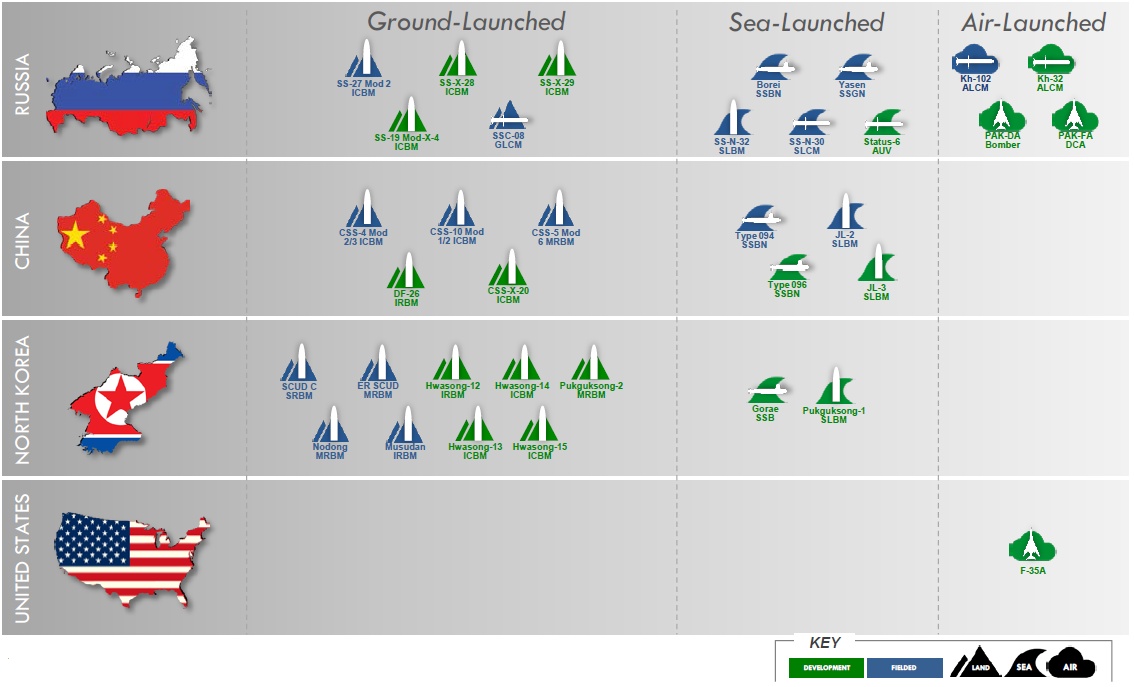
Figure 1. Nuclear Delivery Systems Since 2010
Data provided by the DoDRUSSIA
Russia considers the United States and the North Atlantic Treaty Organization (NATO) to be the principal threats to its contemporary geopolitical ambitions. Russian strategy and doctrine emphasize the potential coercive and military uses of nuclear weapons. It mistakenly assesses that the threat of nuclear escalation or actual first use of nuclear weapons would serve to "de-escalate" a conflict on terms favorable to Russia. These mistaken perceptions increase the prospect for dangerous miscalculation and escalation.
Russia has sought to enable the implementation of its strategy and doctrine through a comprehensive modernization of its nuclear arsenal. Russia's strategic nuclear modernization has increased, and will continue to increase its warhead delivery capacity, and provides Russia with the ability to rapidly expand its deployed warhead numbers.
In addition to modernizing "legacy" Soviet nuclear systems, Russia is developing and deploying new nuclear warheads and launchers. These efforts include multiple upgrades for every leg of the Russian nuclear triad of strategic bombers, sea-based missiles, and land-based missiles. Russia is also developing at least two new intercontinental range systems, a hypersonic glide vehicle, and a new intercontinental, nuclear-armed, nuclear-powered, undersea autonomous torpedo.
"Nuclear ambitions in the US and Russia over the last 20 years have evolved in opposite directions. Reducing the role of nuclear weapons in US security strategy is a US objective, while Russia is pursuing new concepts and capabilities for expanding the role of nuclear weapons in its security strategy."
U.S. National Intelligence Council, 2012

Russian President Vladimir Putin and Defense Minister General Sergey Shoigu in the National Defense Council Center. (Photo by Russian Ministry of Defense)
Russia possesses significant advantages in its nuclear weapons production capacity and in non-strategic nuclear forces over the U.S. and allies. It is also building a large, diverse, and modern set of non-strategic systems that are dual-capable (may be armed with nuclear or conventional weapons). These theater- and tactical-range systems are not accountable under the New START Treaty and Russia's non-strategic nuclear weapons modernization is increasing the total number of such weapons in its arsenal, while significantly improving its delivery capabilities. This includes the production, possession, and flight testing of a ground-launched cruise missile in violation of the INF Treaty. Moscow believes these systems may provide useful options for escalation advantage. Finally, despite Moscow's frequent criticism of U.S. missile defense, Russia is also modernizing its long-standing nuclear-armed ballistic missile defense system and designing a new ballistic missile defense interceptor.
RESPONDING TO RUSSIA'S INF TREATY VIOLATION
In July 2014, the United States declared Russia to be in violation of the INF Treaty for the development of the SSC-8 ground-launched cruise missile system. The United States has since pressed Russia to return to compliance with the Treaty.
The North Atlantic Council has emphasized that, "full compliance with the INF Treaty is essential," and "identified a Russian missile system that raises serious concerns; NATO urges Russia to address these concerns in a substantial and transparent way." – December 15th, 2017
RESPONSE MEASURES:
Diplomatic Measures – The United States continues to seek a diplomatic resolution through all viable channels, including the INF's Special Verification Commission. Allies have emphasized that a situation whereby the United States and other parties are abiding by the Treaty, and Russia were not, would be a grave and urgent concern.
Economic Measures – The United States has sanctioned Russian companies involved in the development and manufacture of Russia's prohibited cruise missile system.
Military Measures – The United States is commencing INF Treaty-compliant research and development by reviewing military concepts and options for conventional, ground-launched, intermediate-range missile systems.
Russia's increased reliance on nuclear capabilities to include coercive threats, nuclear modernization programs, refusal to negotiate any limits on its non-strategic nuclear forces, and its decision to violate the INF Treaty and other commitments all clearly indicate that Russia has rebuffed repeated U.S. efforts to reduce the salience, role, and number of nuclear weapons.
CHINA
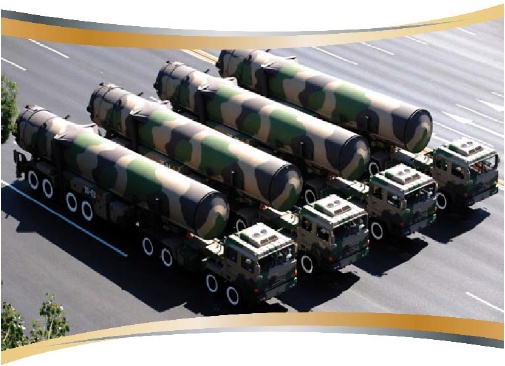
China's CSS-X-20 ICBM on parade in 2015. (Photo by Xinhua News)
Consistent with Chinese President Xi's statement at the 19th Party Congress that China's military will be "fully transformed into a first tier force" by 2050, China continues to increase the number, capabilities, and protection of its nuclear forces. While China's declaratory policy and doctrine have not changed, its lack of transparency regarding the scope and scale of its nuclear modernization program raises questions regarding its future intent. China has developed a new road-mobile strategic intercontinental ballistic missile (ICBM), a new multi-warhead version of its DF-5 silo-based ICBM, and its most advanced ballistic missile submarine armed with new submarine-launched ballistic missiles (SLBM). It has also announced development of a new nuclear-capable strategic bomber, giving China a nuclear triad. China has also deployed a nuclear-capable precision guided DF-26 intermediate-range ballistic missile capable of attacking land and naval targets. As with Russia, despite criticizing U.S. homeland missile defense–which is directed against limited missile threats–China has announced that it is testing a new mid-course missile defense system, plans to develop sea-based mid-course ballistic missile defense, and is developing theater ballistic missile defense systems, but has provided few details.
NORTH KOREA
The security environment has worsened given these developments and the threats posed by further proliferation of nuclear weapons.
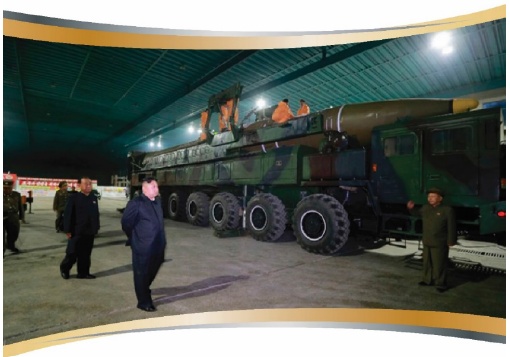
Kim Jong-un inspecting the Hwasong-14 ICBM. (Photo by the Korean Central News Agency)
North Korea has accelerated its provocative pursuit of nuclear weapons and missile capabilities, and expressed explicit threats to use nuclear weapons against the United States and its allies in the region. North Korean officials insist that they will not give up nuclear weapons, and North Korea may now be only months away from the capability to strike the United States with nuclear-armed ballistic missiles. In the past few years, North Korea has dramatically increased its missile flight testing, most recently including the testing of intercontinental-range missiles capable of reaching the U.S. homeland. It has conducted six nuclear tests since 2006, including a test of a significantly higher-yield device. Further, North Korea continues to produce plutonium and highly-enriched uranium for nuclear weapons. Given North Korea's current and emerging nuclear capabilities; existing chemical, biological, and conventional capabilities; and extremely provocative rhetoric and actions, it has come to pose an urgent and unpredictable threat to the United States, allies, and partners. Consequently, the United States reaffirms that North Korea's illicit nuclear program must be completely, verifiably, and irreversibly eliminated, resulting in a Korean Peninsula free of nuclear weapons.
"North Korea's nuclear weapons and missile programs will continue to pose a serious threat to US interests and to the security environment in East Asia in 2017. North Korea's export of ballistic missiles and associated materials to several countries, including Iran and Syria, and its assistance to Syria's construction of a nuclear reactor, destroyed in 2007, illustrate its willingness to proliferate dangerous technologies."
Director of National Intelligence, Daniel R. Coats, Worldwide Threat Assessment, 2017
North Korea's continued pursuit of nuclear weapons capabilities poses the most immediate and dire proliferation threat to international security and stability. In addition to explicit nuclear threats enabled by North Korea's development of nuclear weapons and delivery systems, North Korea poses a "horizontal" proliferation threat as a potential source of nuclear weapons or nuclear materials for other proliferators. North Korea's nuclear weapons program also increases nuclear proliferation pressures on non-nuclear weapon states that North Korea directly and explicitly threatens with nuclear attack.
IRAN
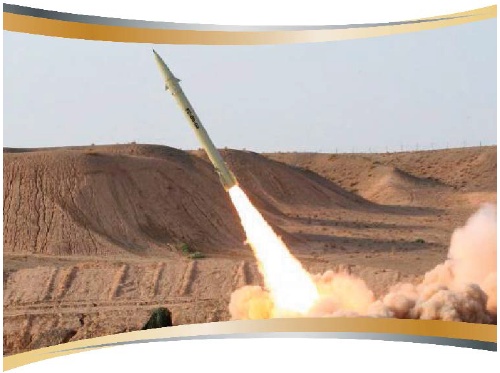
Iranian test launch of a modified Fateh-110. (Photo by the Iranian Ministry of Defense)
Iran, too, poses proliferation threats. Iran's Supreme Leader, Ayatollah Ali Khamenei, has most recently stated that, "America is the number one enemy of our nation." While Iran has agreed to constraints on its nuclear program in the Joint Comprehensive Plan of Action (JCPOA), absent extensive international actions many of the agreement's restrictions on Iran's nuclear program will end by 2031. In addition, Iran retains the technological capability and much of the capacity necessary to develop a nuclear weapon within one year of a decision to do so. Iran's development of increasingly long-range ballistic missile capabilities, and its aggressive strategy and activities to destabilize neighboring governments, raises questions about its long-term commitment to foregoing nuclear weapons capability. Were Iran to pursue nuclear weapons after JCPOA restrictions end, pressures on other countries in the region to acquire their own nuclear weapons would increase.
Nuclear terrorism remains a threat to the United States and to international security and stability. Preventing the illicit acquisition of a nuclear weapon, nuclear materials, or related technology and expertise by a violent extremist organization is a significant U.S. national security priority. The more states–particularly rogue states–that possess nuclear weapons or the materials, technology, and knowledge required to make them, the greater the potential risk of terrorist acquisition. Further, given the nature of terrorist ideologies, we must assume that they would employ a nuclear weapon were they to acquire one.
UNCERTAINTIES REGARDING THE FUTURE SECURITY ENVIRONMENT AND THE THREATS IT MAY POSE
The significant and rapid worsening of the international security environment since the 2010 NPR demonstrates that unanticipated developments and uncertainty about near- and long-term threats to the United States, allies, and partners are factors we must consider in formulating U.S. nuclear policy, strategy, and posture. These uncertainties are a concern in the near term, and potentially profound in the long term. Because this NPR lays the policy, strategy, and programmatic foundation for sustaining and replacing the entire U.S. nuclear force needed to address threats decades into the future, it focuses on the implications of such uncertainties.
There are two forms of uncertainty regarding the future security environment which U.S. nuclear policy, strategy, and posture must take into account. The first is geopolitical uncertainty. This includes the potential for rapid shifts in how other states view the United States, its allies, and partners; changing alignments among other states; and relative power shifts in the international system. The collapse of the government of a nuclear-armed state or a so-called "proliferation cascade" would also fall in this category.
The second form of uncertainty is technological. This includes the potential for unanticipated technological breakthroughs in the application of existing technologies, or the development of wholly new technologies, that change the nature of the threats we face and the capabilities required to address them effectively. For example, breakthroughs that would render U.S. nuclear forces or U.S. command and control of those forces highly vulnerable to attack would dramatically affect U.S. nuclear force requirements, policy, and posture. The proliferation of highly-lethal biological weapons is another example.
Such geopolitical and technological uncertainties are, fundamentally, unpredictable, particularly over the long term. Yet, it is near certain that unanticipated developments will arise. Consequently, we must take them into account to the extent possible as we plan the U.S. nuclear forces and related capabilities needed now and in future decades. Ensuring that U.S. nuclear capabilities have the flexibility and attributes necessary to respond to the possible shocks of a changing threat environment is our responsibility to future generations.
III. WHY U.S. NUCLEAR CAPABILITIES?
"Our nuclear deterrent underwrites all courses of diplomacy and every military operation... there is a direct line between a safe, secure, and reliable nuclear deterrent...and our responsibility as global defenders of freedom."
U.S. Air Force Chief of Staff, General David Goldfein, 2017
U.S. NUCLEAR CAPABILITIES
The fundamental reasons why U.S. nuclear capabilities and deterrence strategies are necessary for U.S., allied, and partner security are readily apparent. As Secretary of Defense Mattis has observed, "a safe, secure, and effective nuclear deterrent is there to ensure a war that can never be won, is never fought." The deterrence effects they provide are unique and essential to preventing adversary nuclear attacks, which is the highest defense priority of the United States.
U.S. nuclear capabilities cannot prevent all conflict or provocations, and should not be expected to do so. But, the U.S. triad of strategic bombers, ICBMs, and SLBMs, supplemented by dual-capable aircraft (DCA), overshadows any adversary's calculations of the prospective benefits of aggression and thus contributes uniquely both to deterring nuclear and non-nuclear attack and to assuring allies and partners. The triad and DCA are essential for these purposes, and will be so for the foreseeable future. As the Bipartisan Congressional Strategic Posture Commission–led by former Defense Secretaries William Perry and James Schlesinger–emphasized in 2009, "The conditions that might make possible the global elimination of nuclear weapons are not present today and their creation would require a fundamental transformation of the world political order." That fundamental transformation has not since taken place, nor is it emerging.
For centuries prior to the era of nuclear deterrence, periodic and catastrophic wars among Great Powers were the norm, waged with ever more destructive weapons and inflicting ever higher casualties and damage to society. During the first half of the 20th century and just prior to the introduction of U.S. nuclear deterrence, the world suffered 80–100 million fatalities over the relatively short war years of World Wars I and II, averaging over 30,000 fatalities per day.
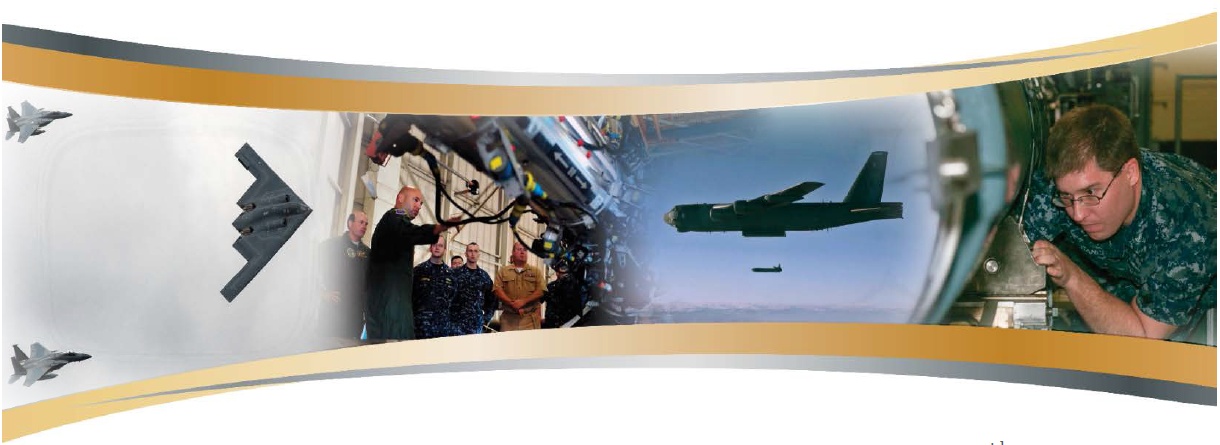
B-2 Stealth Bomber and two F-15 Strike Eagle aircraft.
Air Force Captain discusses U.S. Strategic Command's bomber and intercontinental ballistic missile capabilities with visiting Navy Reserve personnel.
An unarmed AGM-86B Air-Launched Cruise Missile is released from a B-52H Stratofortress.
Machinist's Mate (Weapons) 3rd Class, assigned to the OHIO-class ballistic-missile submarine USS Louisiana (SSBN 743) receives hands-on training inside the Weapons Launch Control Team Trainer at Trident Training Facility at Naval Base Kitsap-Bangor.Since the introduction of U.S. nuclear deterrence, U.S. nuclear capabilities have made essential contributions to the deterrence of nuclear and non-nuclear aggression. The subsequent absence of Great Power conflict has coincided with a dramatic and sustained reduction in the number of lives lost to war globally, as illustrated by Figure 2.
WARTIME FATALITIES % OF THE WORLD POPULATION (CIVILIAN AND MILITARY)
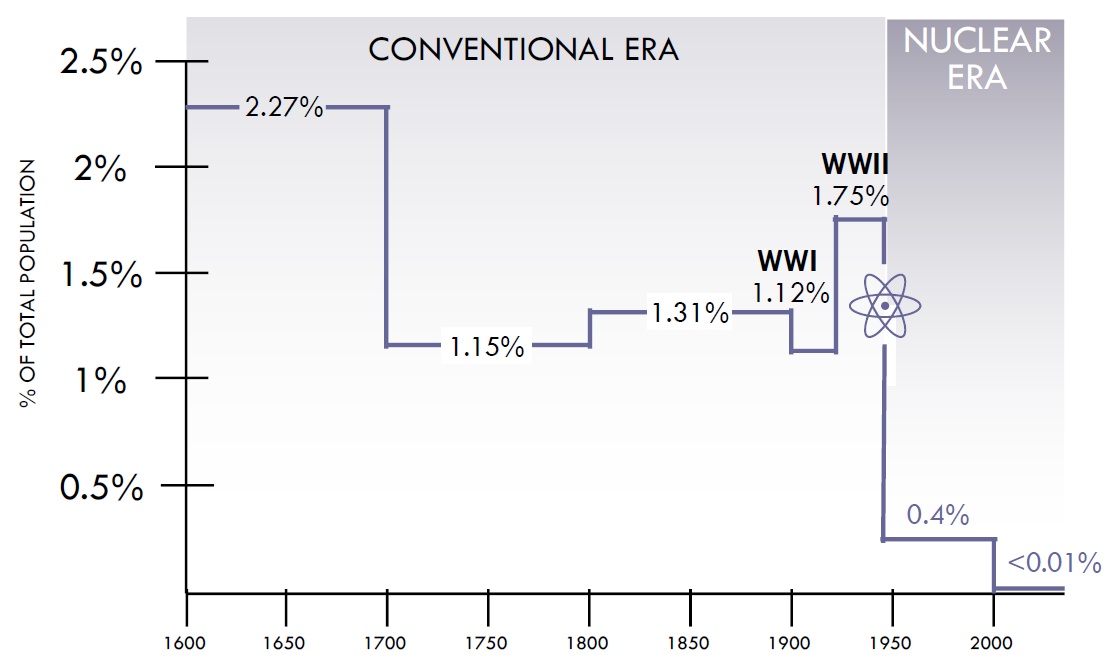
Figure 2. Wartime Fatalities Percentage of World Population
Data from the DoD Historical Office
Non-nuclear forces also play essential deterrence roles. Alone, however, they do not provide comparable deterrence effects, as reflected by the periodic and catastrophic failures of conventional deterrence to prevent Great Power wars throughout history. Similarly, conventional forces alone do not adequately assure many allies and partners. Rather, these states place enormous value on U.S. extended nuclear deterrence, which correspondingly is also key to non-proliferation.
Properly sustained U.S. nuclear deterrence helps prevent attacks against the United States, allies, and partners and the return to the frequent Great Power warfare of past centuries. In the absence of U.S. nuclear deterrence, the United States, allies, and partners would be vulnerable to coercion and attack by adversaries who retain or expand nuclear arms and increasingly lethal non-nuclear capabilities. Until the "fundamental transformation of the world political order" takes place, U.S. nuclear weapons remain necessary to prevent war and safeguard the Nation.
IV. ENDURING NATIONAL OBJECTIVES AND THE ROLES OF NUCLEAR WEAPONS IN U.S. NATIONAL SECURITY STRATEGY
"We believe that by improving deterrence across the broad spectrum, we will reduce to an even lower point the probability of a nuclear clash between ourselves and other major powers."
Secretary of Defense James Schlesinger, 1974
The highest U.S. nuclear policy and strategy priority is to deter potential adversaries from nuclear attack of any scale. However, deterring nuclear attack is not the sole purpose of nuclear weapons. Given the diverse threats and profound uncertainties of the current and future threat environment, U.S. nuclear forces play the following critical roles in U.S. national security strategy. They contribute to the:
- Deterrence of nuclear and non-nuclear attack;
- Assurance of allies and partners;
- Achievement of U.S. objectives if deterrence fails; and
- Capacity to hedge against an uncertain future.
These roles are complementary and interrelated, and we must assess the adequacy of U.S. nuclear forces against each role and the strategy designed to fulfill it. Preventing proliferation and denying terrorists access to finished weapons, material, or expertise are also key considerations in the elaboration of U.S. nuclear policy and requirements. These multiple roles and objectives are the guiding pillars for U.S. nuclear policy, strategy, and requirements.
DETERRENCE OF NUCLEAR AND NON-NUCLEAR ATTACK
The highest U.S. nuclear policy and strategy priority is to deter potential adversaries from nuclear attack of any scale. Potential adversaries must understand that the United States has the will and response options necessary to deter nuclear attack under any conditions.
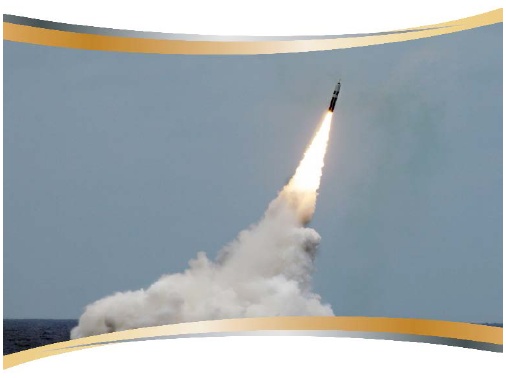
An unarmed Trident II D5 missile launches from the Ohio-class fleet ballistic-missile submarine USS Maryland (SSBN 738) off the coast of Florida. The test launch was part of the U.S. Navy Strategic Systems Programs demonstration and shakedown operation certification process. The successful launch certified the readiness of an SSBN crew and the operational performance of the submarine's strategic weapons system before returning to operational availability (U.S. Navy Photo)
The specific application of deterrence strategies changes across time and circumstance, but the fundamental nature of deterrence endures: it is about decisively influencing an adversary's decision calculus to prevent attack or the escalation of a conflict. Potential adversaries must understand that aggression against the United States, allies, and partners will fail and result in intolerable costs for them. We deter attacks by ensuring the expected lack of success and prospective costs far outweigh any achievable gains.
U.S. deterrence strategy has always integrated multiple instruments of national power to deter nuclear and non-nuclear attack. Integrating and exercising all instruments of power has become increasingly important as potential adversaries integrate their military capabilities, expanding the range of potential challenges to be deterred. This is particularly true of threats from potential adversaries of limited nuclear escalation and non-nuclear strategic attack.
For U.S. deterrence to be effective across the emerging range of threats and contexts, nuclear-armed potential adversaries must recognize that their threats of nuclear escalation do not give them freedom to pursue non-nuclear aggression. Potential adversaries must understand that: 1) the United States is able to identify them and hold them accountable for acts of aggression, including new forms of aggression; 2) we will defeat non-nuclear strategic attacks; and, 3) any nuclear escalation will fail to achieve their objectives, and will instead result in unacceptable consequences for them.
For effective deterrence, the United States will acquire and maintain the full range of capabilities needed to ensure that nuclear or non-nuclear aggression against the United States, allies, and partners will fail to achieve its objectives and carry with it the credible risk of intolerable consequences for the adversary. U.S. forces will ensure their ability to integrate nuclear and non-nuclear military planning and operations. Combatant Commands and Service components will be organized and resourced for this mission, and will plan, train, and exercise to integrate U.S. nuclear and non-nuclear forces and operate in the face of adversary nuclear threats and attacks. The United States will coordinate integration activities with allies facing nuclear threats, and will examine opportunities for additional allied burden sharing in the nuclear deterrence mission.
An important element of maintaining effective deterrence is the articulation of U.S. declaratory policy regarding the potential employment of nuclear weapons:
The United States would only consider the employment of nuclear weapons in extreme circumstances to defend the vital interests of the United States, its allies, and partners. Extreme circumstances could include significant non-nuclear strategic attacks. Significant non-nuclear strategic attacks include, but are not limited to, attacks on the U.S., allied, or partner civilian population or infrastructure, and attacks on U.S. or allied nuclear forces, their command and control, or warning and attack assessment capabilities.
The United States will not use or threaten to use nuclear weapons against non-nuclear weapons states that are party to the NPT and in compliance with their nuclear non-proliferation obligations.
Given the potential of significant non-nuclear strategic attacks, the United States reserves the right to make any adjustment in the assurance that may be warranted by the evolution and proliferation of non-nuclear strategic attack technologies and U.S. capabilities to counter that threat.
To help preserve deterrence and the assurance of allies and partners, the United States has never adopted a "no first use" policy and, given the contemporary threat environment, such a policy is not justified today. It remains the policy of the United States to retain some ambiguity regarding the precise circumstances that might lead to a U.S. nuclear response.
In addition, the United States will maintain a portion of its nuclear forces on alert day-today, and retain the option of launching those forces promptly. This posture maximizes decision time and preserves the range of U.S. response options. It also makes clear to potential adversaries that they can have no confidence in strategies intended to destroy our nuclear deterrent forces in a surprise first strike.
The de-alerting of U.S. ICBMs would create the potential for dangerous deterrence instabilities by rendering them vulnerable to a potential first strike and compelling the United States to rush to re-alert in a crisis or conflict. Further, U.S. ICBMs are not on "hair-trigger alert," as sometimes mistakenly is claimed. As the bipartisan 2009 Perry-Schlesinger Commission report stated, hair trigger alert "is simply an erroneous characterization of the issue. The alert postures of both countries [the United States and the Russian Federation] are in fact highly stable. They are subject to multiple layers of control, ensuring clear civilian and indeed Presidential decision-making." Over more than half a century, the U.S. has established a series of measures and protocols to ensure that ICBMs are safe, secure, and under constant control. Any U.S. decision to employ nuclear weapons would follow a deliberative process. Finally, the United States will continue its long-standing practice of open-ocean targeting of its strategic nuclear forces day-to-day as a confidence and security building measure.
ASSURANCE OF ALLIES AND PARTNERS
The United States has extended nuclear deterrence commitments that assure European, Asian, and Pacific allies. The United States will ensure the credibility and effectiveness of those commitments.

U.S. Air Force F-35A Lightning IIs and Japanese Air Self Defense Force F-15 Eagles fly in formation during bi-lateral training December 4, 2017, over the Pacific Ocean. (U.S. Air Force photo)
Assurance is a common goal and advances our common security interests. It is based on collaboration with allies and partners to deter or defeat the threats we face. It includes sustained allied dialogues to understand each other's threat perceptions and to arrive at a shared understanding of how best to demonstrate our collective capabilities and resolve. No country should doubt the strength of our extended deterrence commitments or the strength of U.S. and allied capabilities to deter, or if necessary defeat, any potential adversary's nuclear or non-nuclear aggression.
In many cases, effectively assuring allies and partners depends on their confidence in the credibility of U.S. extended nuclear deterrence. They have reaffirmed that extended nuclear deterrence is essential to their security, enabling most to eschew possession of nuclear weapons and thereby contributing to U.S. non-proliferation goals.
ACHIEVE U.S. OBJECTIVES SHOULD DETERRENCE FAIL
For deterrence to be credible, the United States must prepare to respond effectively if deterrence were to fail, in ways that will achieve U.S. objectives while protecting U.S., allied, and partner interests. Non-nuclear capabilities can complement but not replace U.S. nuclear capabilities for this purpose.

A radar navigator assigned to the 2nd Bomb Wing, Barksdale Air Force Base, La., watches monitors on a B-52 Stratofortress during a mission in support of bomber assurance and deterrence operations at Royal Air Force Fairford, England, September 19, 2017. (Air Force photo)
All U.S. Presidents since 1945 have considered U.S. employment of nuclear weapons only in extreme circumstances and for defensive purposes. If deterrence fails, the initiation and conduct of nuclear operations would adhere to the law of armed conflict and the Uniform Code of Military Justice. The United States will strive to end any conflict and restore deterrence at the lowest level of damage possible for the United States, allies, and partners, and minimize civilian damage to the extent possible consistent with achieving objectives.
Every U.S. administration over the past six decades has called for flexible and limited U.S. nuclear response options, in part to support the goal of reestablishing deterrence following its possible failure. This is not because reestablishing deterrence is certain, but because it may be achievable in some cases and contribute to limiting damage, to the extent feasible, to the United States, allies, and partners. The goal of limiting damage if deterrence fails in a regional contingency calls for robust adaptive planning to defeat and defend against attacks, including missile defense and capabilities to locate, track, and target mobile systems of regional adversaries. These and other non-nuclear capabilities, which we are now strengthening, can complement but not replace U.S. nuclear forces for this purpose. In the case of missile threats from regional actors in particular, U.S. missile defense and offensive options provide the basis for significant damage limitation in the event deterrence fails.
HEDGE AGAINST AN UNCERTAIN FUTURE
The United States will continue efforts to create a more cooperative and benign security environment, but must also hedge against prospective and unanticipated risks. Nuclear capabilities alone do not provide the basis for hedging against future uncertainty; non-nuclear forces also play a critical role. However, U.S. nuclear capabilities provide a necessary, unique, and currently irreplaceable contribution.

Airman 1st Class, 90th Missile Maintenance Squadron maintainer, removes the screws holding the nose point of a Minuteman III ICBM to the rest of the reentry system inside a payload transporter in the F.E. Warren Air Force Base, Wyo., missile complex, August 24, 2016. The system was separated into two parts and secured inside a payload transporter. The 90th MMXS maintains 150 Minuteman III ICBMs and the associated LFs spread throughout three states and 9,600 square miles. (U.S. Air Force photo)
Hedging strategies help reduce risk and avoid threats that otherwise may emerge over time. Given the increasing prominence of nuclear weapons in the defense policies and strategies of Russia and China, and the uncertainties of the future threat environment, particularly from illicit North Korean nuclear and missile programs, U.S. nuclear capabilities and the ability to quickly modify them are essential to mitigate or overcome risk. The capacity to hedge contributes to deterrence and can help reduce potential adversaries' confidence that they can gain an advantage via a "break out" or expansion of nuclear capabilities.
Our hedging strategies must also help mitigate and overcome unexpected technical risks throughout the life cycle of U.S. nuclear capabilities, and must mitigate risk in the development, deployment, and operation of U.S. nuclear forces. As we acquire forces, and those forces age, this requires a framework to continually assess risks and threats, identify whether to accept or mitigate risks, and guide development of appropriate and effective solutions.
V. TAILORED STRATEGIES AND FLEXIBLE CAPABILITIES
"The challenges that each situation may present, such as time, place and circumstance, are distinct. Therefore, flexibility and adaptiveness are essential in a defence planning process that can never be informed reliably about the future contexts for action and requirements."
Professor Colin S. Gray, 2017
TAILORED DETERRENCE
There is no "one size fits all" for deterrence. The requirements for effective deterrence vary given the need to address the unique perceptions, goals, interests, strengths, strategies, and vulnerabilities of different potential adversaries. The deterrence strategy effective against one potential adversary may not deter another. Consequently, the United States will apply a tailored approach to effectively deter across a spectrum of adversaries, threats, and contexts.
Tailored deterrence strategies are designed to communicate the costs of aggression to potential adversaries, taking into consideration how they uniquely calculate costs and risks. This calls for a diverse range and mix of U.S. deterrence options, now and into the future, to ensure strategic stability.
Tailored deterrence also calls for on-going analyses to adapt our strategies to different potential adversaries and contingencies. These analyses address how potential adversaries define unacceptable damage, and how the United States can credibly communicate to them the risks and costs that would accompany their aggression. Adjusting our deterrence strategies accordingly is what it means to tailor deterrence.
FLEXIBLE CAPABILITIES
Flexibility means having the appropriate range and mix of nuclear and other capabilities required to tailor deterrence strategies now and into the future, and to fulfill the other roles of nuclear weapons in U.S. national security strategy. Flexibility must address a spectrum of adversaries and threats and enable adjustments over time. U.S. nuclear strategies, forces, and NC3 must be increasingly flexible to sustain that range of capabilities and options.

An unarmed Trident II D5 missile launches from the OHIO-class fleet ballistic-missile submarine USS Maryland (SSBN 738) off the coast of Florida.
Two U.S. Air Force B-1B Lancers (not pictured) joined up with Republic of Korea air force F-15s during a 10-hour mission from Andersen Air Force Base, Guam, into Japanese airspace and over the Korean Peninsula.
A U.S. Air Force T-38 Talon aircraft and B-2 Spirit aircraft fly in formation during a training mission over Whiteman Air Force Base.
Air Force Technical Sergeant and Staff Sergeant test communications equipment required for mobile nuclear command and control capabilities at Offutt Air Force Base.The United States has understood the value of flexibility for nuclear deterrence for six decades, but its importance is now magnified by the emerging diversity of nuclear and non-nuclear strategic threats and the dynamism and uncertainties of the security environment. This need for flexibility to tailor U.S. capabilities and strategies to meet future requirements and unanticipated developments runs contrary to a rigid, continuing policy of "no new nuclear capabilities." Potential adversaries do not stand still. On the contrary, they seek to identify and exploit weaknesses in U.S. capabilities and strategy. Thus, U.S. future force requirements for deterrence cannot prudently be considered fixed. The United States must be capable of developing and deploying new capabilities, if necessary, to deter, assure, achieve U.S. objectives if deterrence fails, and hedge against uncertainty.
VI. U.S. STRATEGIES TO COUNTER CONTEMPORARY THREATS
"The number one priority of the Department of Defense is that we maintain a safe, secure and effective nuclear deterrent so we make certain those weapons are never used."
Secretary of Defense James Mattis, August 2017
A TAILORED STRATEGY FOR RUSSIA
Russia is not the Soviet Union and the Cold War is long over. However, despite our best efforts to sustain a positive relationship, Russia now perceives the United States and NATO as its principal opponent and impediment to realizing its destabilizing geopolitical goals in Eurasia.
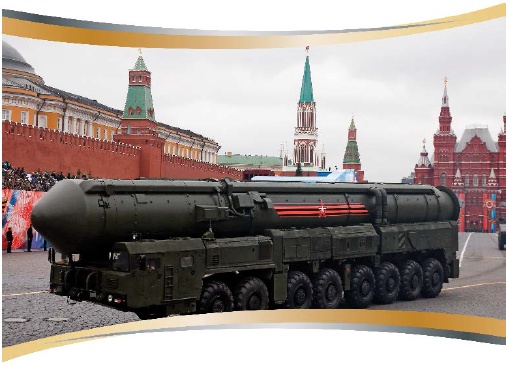
Russian SS-27 Mod 2 ICBM on parade in Moscow. (Photo by the Russian Ministry of Defense)
Russia has significantly increased the capabilities of its non-nuclear forces to project power into regions adjacent to Russia and, as previously discussed, has violated multiple treaty obligations and other important commitments. Most concerning are Russia's national security policies, strategy, and doctrine that include an emphasis on the threat of limited nuclear escalation, and its continuing development and fielding of increasingly diverse and expanding nuclear capabilities. Moscow threatens and exercises limited nuclear first use, suggesting a mistaken expectation that coercive nuclear threats or limited first use could paralyze the United States and NATO and thereby end a conflict on terms favorable to Russia. Some in the United States refer to this as Russia's "escalate to de-escalate" doctrine. "De-escalation" in this sense follows from Moscow's mistaken assumption of Western capitulation on terms favorable to Moscow.
Effective U.S. deterrence of Russian nuclear attack and non-nuclear strategic attack now requires ensuring that the Russian leadership does not miscalculate regarding the consequences of limited nuclear first use, either regionally or against the United States itself. Russia must instead understand that nuclear first-use, however limited, will fail to achieve its objectives, fundamentally alter the nature of a conflict, and trigger incalculable and intolerable costs for Moscow. Our strategy will ensure Russia understands that any use of nuclear weapons, however limited, is unacceptable.
The U.S. deterrent tailored to Russia, therefore, will be capable of holding at risk, under all conditions, what Russia's leadership most values. It will pose insurmountable difficulties to any Russian strategy of aggression against the United States, its allies, or partners and ensure the credible prospect of unacceptably dire costs to the Russian leadership if it were to choose aggression.
This strategy will ensure Russia understands it has no advantages in will, non-nuclear capabilities, or nuclear escalation options that enable it to anticipate a possible benefit from non-nuclear aggression or limited nuclear escalation. Correcting any Russian misperceptions along these lines is important to maintaining deterrence in Europe and strategic stability.
Correspondingly, at the 2016 NATO Summit, the Alliance emphasized that, "no one should doubt NATO's resolve if the security of any of its members were to be threatened. NATO will maintain the full range of capabilities necessary to deter and defend against any threat to the safety and security of our populations, wherever it should arise."
To correct any Russian misperceptions of advantage and credibly deter Russian nuclear or non-nuclear strategic attacks–which could now include attacks against U.S. NC3–the President must have a range of limited and graduated options, including a variety of delivery systems and explosive yields. These requirements put a premium on the survivability, flexibility and readiness of Western nuclear and non-nuclear capabilities to hold diverse types of Russian targets at risk throughout a crisis or conflict, and point to the continuing great value of the flexibility inherent in the combination of the U.S. nuclear triad, U.S. and other NATO non-strategic nuclear forces deployed in Europe, and the nuclear forces of our British and French allies.
A TAILORED STRATEGY FOR CHINA
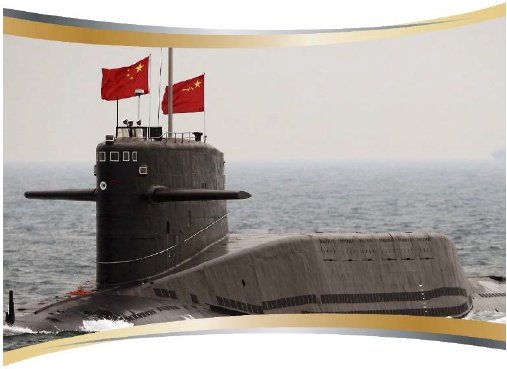
A JIN-class Type 094 ballistic missile submarine. (Photo by the People' s Liberation Army-Navy)
China's military modernization and pursuit of regional dominance have emerged as a major challenge to U.S. interests in Asia. It has adopted an increasingly assertive posture in disputes with its neighbors, many of whom are U.S. allies or partners. These encompass a variety of historical and border disputes, including over territorial boundaries, claims to contested island territory, and an island-building campaign in the South China Sea. China possesses nuclear warheads on protected ICBMs and SLBMs capable of reaching the United States and nuclear-armed, theater-range ballistic missiles capable of reaching U.S. territory, allies, partners, forces, and bases in the region. China's expanding non-nuclear military capabilities include space and cyber warfare capabilities that could decisively affect the outcome of a conflict.
China is developing capabilities to counter U.S. power projection operations in the region and to deny the United States the capability and freedom of action to protect U.S., allied, and partner interests. Direct military conflict between China and the United States would have the potential for nuclear escalation. Our tailored strategy for China is designed to prevent Beijing from mistakenly concluding that it could secure an advantage through the limited use of its theater nuclear capabilities or that any use of nuclear weapons, however limited, is acceptable.
The United States will maintain the capability to credibly threaten intolerable damage as Chinese leaders calculate costs and benefits, such that the costs incurred as a result of Chinese nuclear employment, at any level of escalation, would vastly outweigh any benefit.
The United States is prepared to respond decisively to Chinese non-nuclear or nuclear aggression. U.S. exercises in the Asia-Pacific region, among other objectives, demonstrate this preparedness, as will increasing the range of graduated nuclear response options available to the President. Both steps will strengthen the credibility of our deterrence strategy and improve our capability to respond effectively to Chinese limited nuclear use if deterrence were to fail. The United States will also continue to seek a meaningful dialogue with China on our respective nuclear policies, doctrine, and capabilities in pursuit of a peaceful security environment and stable relations.
A TAILORED STRATEGY FOR NORTH KOREA
North Korea poses a clear and grave threat to U.S. and allied security. North Korea openly states that its missiles are intended to deliver nuclear strikes against U.S., South Korean, and Japanese cities. North Korean state agencies have made numerous reckless nuclear threats, such as, "Japan is no longer needed to exist near us," and Japan "should be sunken into the sea by [North Korea's] nuclear bomb," and "Let's reduce the U.S. mainland to ashes and darkness."
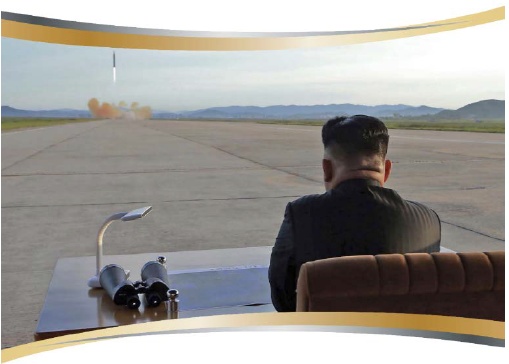
Kim Jong-un observing a recent missile launch. (Photo by the Korean Central News Agency)
A complete, verifiable and irreversible nuclear-free Korean peninsula is a long-standing U.S. objective. Yet, North Korea has prioritized continuing investments in nuclear capabilities over the well-being of the North Korean people, and also possesses significant conventional, cyber, chemical, and biological capabilities. Its expansive nuclear and missile programs suggest the potential for nuclear first use in support of conventional operations. The Kim regime may mistakenly believe that nuclear capabilities give it freedom to engage in a spectrum of bold provocations, including military attacks on South Korean territory and naval vessels, and test launching missiles over Japan.
For North Korea, the survival of the Kim regime is paramount. Our deterrence strategy for North Korea makes clear that any North Korean nuclear attack against the United States or its allies and partners is unacceptable and will result in the end of that regime. There is no scenario in which the Kim regime could employ nuclear weapons and survive. Further, we will hold the Kim regime fully responsible for any transfer of nuclear weapons technology, material or expertise to any state or non-state actor.
North Korea relies on hardened and deeply buried facilities to secure the Kim regime and its key military and command and control capabilities. It uses underground facilities and natural terrain features to protect North Korean military forces. Consequently, the United States will continue to field a range of conventional and nuclear capabilities able to hold such targets at risk.
In addition to ensuring the ability to impose intolerable costs on the Kim regime, the United States and allies have defensive and offensive capabilities to intercept and otherwise defeat North Korea's missile capabilities, and thereby limit or preclude North Korea's ability to conduct effective missile strikes. Japan and South Korea have long expressed support for these capabilities. Although North Korea's missile forces are expanding and increasingly mobile, U.S. and allied missile defenses are increasingly capable against North Korea's missile threat, and the United States has the early warning systems and strike capabilities necessary to degrade North Korean missile capabilities prior to launch. We will continually improve these defensive capabilities as needed to stay ahead of North Korean missile threats if they continue to grow, while also taking steps to preclude an arms race with China or Russia.
A TAILORED STRATEGY FOR IRAN
Iran views U.S. influence in the Middle East as the foremost threat to Iran's goal to establish itself as the dominant regional power. Iran is committed to increasing its influence over neighboring countries and countering U.S. influence. This goal directly threatens U.S. allies and partners, and Iran's defense policy, strategy, and force structure indicate an attempt to create exploitable military advantages.

U.S. Ambassador to the United Nations Nikki Haley discusses evidence of Iran's destabilizing activities in the Middle East and Iran's effort to cover up continued violations of U.N. resolutions during a news conference at Joint Base Anacostia-Bolling in Washington, D.C., December 14, 2017. (DoD photo)
Iran continues to invest in the largest missile program in the Middle East and could, in the future, threaten or deliver nuclear weapons were Iran to acquire them following expiration of the JCPOA, in violation of the NPT and its nuclear non-proliferation obligations. Iran also is developing other non-nuclear military capabilities, including cruise missile systems and cyber warfare capabilities for offensive operations. It may also continue to invest in chemical and biological weapons.
Many of the JCPOA's key constraints on Iran's nuclear program end by 2031, shortening the time it would take Iran to produce enough weapons-grade nuclear material for a nuclear weapon. Iran's development of increasingly accurate and sophisticated ballistic missiles gives it the capability to threaten U.S. forces, allies, and partners in and outside the region. Were Iran to decide to acquire nuclear weapons, pressures on other countries in the region to acquire their own nuclear weapons would increase.
Our deterrence strategy is designed to ensure that the Iranian leadership understands that any non-nuclear strategic attack against the United States, allies, and partners would be defeated, and that the cost would outweigh any benefits. There is no plausible scenario in which Iran may anticipate benefit from launching a strategic attack. Consequently, U.S deterrence strategy includes the capabilities necessary to defeat Iranian non-nuclear, strategic capabilities, including the U.S. defensive and offensive systems capable of precluding or degrading Tehran's missile threats. The United States will continue to strengthen these capabilities as necessary to stay ahead of Iranian threats as they grow. Doing so will enhance U.S. security and that of our regional allies and partners.
EXTENDED DETERRENCE AND TAILORED ASSURANCE
The United States has effectively assured allies and partners for decades. The United States affirms its commitment to the security of its allies and partners, who are concerned about the negative trends in the security environment. This concern is evident both in Europe, where there are understandable allied fears of Russia's nuclear and non-nuclear threats and its use of military force against neighbors, and in Asia, where there are understandable allied fears of China's military rise and North Korea's extreme nuclear and non-nuclear threats.
Our ability to continue assuring allies and partners is challenged by the range and diversity of potential adversaries and the threats they pose. The United States extends deterrence to over 30 countries with different views about the threat environment and the credibility of U.S. security commitments. Similar to deterrence, there is no "one size fits all" strategy for assurance. Assurance measures must continually adapt to the shifting requirements of a highly dynamic threat environment. Our assurance strategies are tailored to the differing requirements of the Euro-Atlantic and Asia-Pacific regions, accounting for the differing security environments, potential adversary capabilities, and varying alliance structures.
Effective deterrence is the foundation for effective assurance. Allies under the U.S. nuclear umbrella, and potential adversaries, should not doubt our extended deterrence commitments or our ability and willingness to fulfill them. In support of U.S. extended deterrence commitments, the United States will maintain the capabilities necessary to deter effectively and, if necessary, to respond effectively and decisively across the spectrum of potential nuclear and non-nuclear scenarios. Critically, for deterrence and assurance purposes, we will retain the capability to adjust our nuclear force structure as required by the security environment. We will develop the necessary infrastructure, capabilities, and political arrangements, now and in the future, to deny adversaries any confidence that they can achieve their regional objectives through nuclear threats or nuclear use.
Assurance also flows from a shared view of the security environment, including: shared interests at stake; deterrence challenges and required capabilities; roles, responsibilities, and expectations; and the appropriate combined response to different conflict scenarios. Consequently, communication and consultation on policy, strategy and capabilities are essential for assurance and will be sustained.
Strengthening Deterrence in Europe
The U.S. commitment to NATO is unwavering. A strong, cohesive nuclear Alliance is the most effective means of deterring aggression and promoting peace and stability in the Euro-Atlantic region. NATO followed the U.S. post-Cold War trend in deemphasizing the role of nuclear weapons in NATO's deterrence and defense posture, but the Alliance never lost sight of the fundamental purpose NATO's nuclear capabilities play in preserving peace, preventing coercion, and deterring aggression.
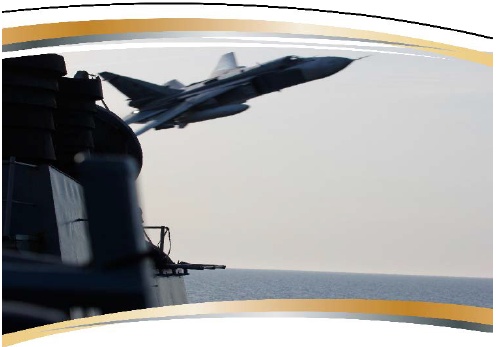
A Russian Sukhoi Su-24 attack aircraft makes a very low altitude pass by USS Donald Cook (DDG 75) April 12, 2016. Donald Cook, an Arleigh Burke-class guided-missile destroyer forward deployed to Rota, Spain, is conducting a routine patrol in the U.S. 6th Fleet area of operations in support of U.S. national security interests in Europe (U.S. Navy photo)
At both the 2014 Wales and 2016 Warsaw summits, NATO recognized that Russia's activities and policies have reduced stability and security, increased unpredictability, and introduced new dangers into the security environment. Importantly, NATO is addressing the changed security environment to make clear that any employment of nuclear weapons against NATO, however limited, would not only fundamentally alter the nature of a conflict, but would result in unacceptable costs to an adversary that would far outweigh the benefit it could hope to achieve. The Alliance has already initiated measures to ensure that NATO's overall deterrence and defense posture, including its nuclear forces, remain capable of addressing any potential adversary's doctrine and capabilities.
In support of these efforts, the United States will consult and work cooperatively with NATO allies to:
- Enhance the readiness and survivability of NATO DCA, improve capabilities required to increase their operational effectiveness, and account for adversary nuclear and non-nuclear capabilities;
- Promote the broadest possible participation of Allies in their agreed burden sharing arrangements regarding the DCA mission, nuclear mission support, and nuclear infrastructure;
- Replace aging aircraft and weapons systems with modernized or life-extended equivalents as they age out;
- Enhance the realism of training and exercise programs to ensure the Alliance can effectively integrate nuclear and non-nuclear operations, if deterrence fails; and
- Ensure the NATO NC3 system is modernized to enable appropriate consultations and effective nuclear operations, improve its survivability, resilience, and flexibility in the most stressful threat environments.
The United States will make available its strategic nuclear forces, and commit nuclear weapons forward-deployed to Europe, to the defense of NATO. These forces provide an essential political and military link between Europe and North America and are the supreme guarantee of Alliance security. Combined with the independent strategic nuclear forces of the United Kingdom and France, as well as Allied burden sharing arrangements, NATO's overall nuclear deterrence forces are essential to the Alliance's deterrence and defense posture now and in the future.
Strengthening Deterrence in Asia
The U.S. commitment to our allies and partners in the Asia-Pacific region is unwavering. As in Europe, strong, cohesive alliances and credible deterrence measures are the most effective means of assurance in the Asia-Pacific region. However, North Korea, China, and Russia each present unique, and in some ways more complex, threats to our allies and interests in the Asia-Pacific region. Further, the perception and immediacy of these threats is unique to different allies.
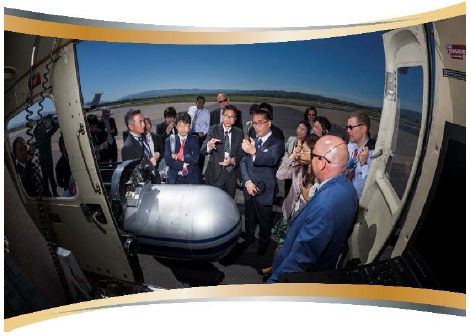
The U.S.-Japan Bilateral Commission on Civil Nuclear Cooperation tour an Aerial Measuring System helicopter. (Photo provided by NNSA)
In addition, our alliance structure in Asia is different than it is in Europe. Rather than a single multinational alliance, in Asia we have a series of bilateral arrangements with varying degrees of multilateral cooperation across different missions. Our nuclear posture, too, is different. Following the Cold War, the United States removed all of its nuclear weapons based in Asia and instead relied on strategic nuclear capabilities, complemented by a sea-launched cruise missile (TLAM-N) to extend nuclear deterrence to our allies. With the retirement of the TLAM-N following the 2010 NPR, the United States currently relies almost exclusively on its strategic nuclear capabilities for nuclear deterrence and the assurance of allies in the region. For these reasons, consultation and cooperative arrangements in the Asia-Pacific region are appropriately different than those in Europe.
To maintain credible extended deterrence and thus effective assurance in this complex environment, the United States will:
- Maintain integrated, flexible, and adaptable U.S. nuclear and non-nuclear capabilities;
- Continue to invest in missile defenses against North Korean missile threats;
- Demonstrate with allies our joint commitment to deterrence through military exercises; and,
- Work with our allies to improve our shared understanding of nuclear dangers and corresponding deterrence requirements through continued consultative dialogues.
HEDGE AGAINST DIVERSE UNCERTAINTIES
The United States will tailor its hedging strategy across the range of potential adversaries and be prepared to meet future risks and challenges that may emerge, but cannot be characterized with certainty today. The combination of a highly dynamic security environment and the rapid advancement and spread of military technology creates a range of possible threat developments for which we must be prepared. Additionally, the United States is embarking on a nuclear force sustainment and replacement program which is just in time. This requires a high degree of concurrency and synchronization and, thus, has the potential for scheduling shortfalls. We cannot predict with confidence when or if any of these potential challenges will occur, but there always exists the potential for geopolitical or technological surprise. Therefore, we must, and will, posture our nuclear capabilities to hedge against multiple potential risks and threat developments.
We will, for example, hedge against the potential rapid growth or emergence of nuclear and non-nuclear strategic threats, including chemical, biological, cyber, and large-scale conventional aggression. The capacity to hedge helps ensure our ability to sustain effective deterrence and assurance amid unexpected change.
Our hedge strategy addresses four categories of potential risk:
- Geopolitical risk includes the emergence of new adversaries, expansion of adversary nuclear forces, changes in adversary strategy and doctrine, new alignments among adversaries, and the further proliferation of nuclear weapons.
- Technological risk includes technical challenges resulting from a breakdown of a key element of U.S. nuclear forces, or from adversaries' technological breakthroughs, that create a new threat to U.S. nuclear deterrent capabilities.
- Operational risk includes the potential for operational shortfalls that reduce the effectiveness of U.S. nuclear forces. It includes reduced availability of deployed forces, intelligence collection gaps that inhibit identification or characterization of designated targets, and any unmet requirement needed to sustain effective deterrence.
- Programmatic risk includes potential risks to the U.S. sustainment of adequate nuclear capabilities such as delays to maintenance programs, the age-out of legacy nuclear systems earlier or more precipitously than anticipated, and an inability to produce needed quantities of unique nuclear materials. These risks are particularly acute today because key elements of the U.S. nuclear acquisition and production infrastructure have "atrophied," as described in 2008 by the Secretaries of Defense and Energy. They noted "existing U.S. nuclear weapons–most of which were designed 20 to 30 years ago–are being maintained well beyond the service life for which they were designed." There is no further margin for delaying U.S. sustainment and replacement programs for our existing nuclear capabilities and nuclear weapons infrastructure. We will avoid shortfalls in the next decade only by carefully managing programmatic risk to those programs.
The U.S strategy for hedging against unexpected challenges is based on two parallel approaches: reducing the likelihood that challenges will emerge in the categories of geopolitical, technological, operational, and programmatic risk; and, reducing the harm that would result if preventive measures prove inadequate. This two-track hedging strategy will help guide the capabilities and size of U.S. nuclear forces and supporting infrastructure.
Preventing the Emergence of Challenges
We will counter the emergence of challenges to U.S. nuclear strategy by emphasizing: 1) the early detection of potential problems; 2) opportunities for risk reduction through diplomacy; and 3) dissuading adversaries from attempting to challenge U.S., allied, and partner security.
Detect and resolve potential challenges early. Detecting and addressing problems before they arise is the most direct way to reduce the likelihood that dangerous technological or operational surprises will emerge. To do so, the Department of Energy's (DOE) National Nuclear Security Administration (NNSA) will continue to conduct robust nuclear weapons surveillance and experimental programs to identify issues early enough to help prevent technical breakdowns, operational shortfalls, and programmatic challenges. DoD will continue to conduct a weapon system test and evaluation program to identify emerging issues early. DoD and NNSA will also work together to conduct ongoing evaluations of the current and potential future security environments. This will include threat-based analyses of what potential adversaries are doing or considering today, as well as what is possible in light of projected advancement and diffusion of technology. Finally, the United States will remain at the forefront of science and technology to reduce the likelihood of technological surprise.
Risk reduction through diplomacy. We will seek opportunities for diplomatic agreements that reduce the likelihood of future security challenges via mutual restraints that reduce the potential for miscalculation in crisis or conflict. Treaties and agreements for this purpose can benefit U.S. security when they are verifiable and compliance can reasonably be expected and enforced as necessary.
Dissuade adversaries from seeking advantage. We will reduce the likelihood of geopolitical challenges by being prepared to respond effectively to changes in the security environment, and being seen as so capable. Adversaries will be less likely to seek strategic advantage through arms competition if the United States clearly demonstrates the capacity and will to meet any such challenge. Therefore, in preparing to respond to geopolitical challenges, we will prioritize measures that would help reduce the likelihood that adversaries will choose to challenge us in the first place.
Mitigating the Potential Consequences of Future Challenges
The United States can hedge in two complementary ways. One is by having a robust nuclear weapon production infrastructure that has the design, engineering, and manufacturing capabilities needed to quickly produce new or additional weapons needed to address changes in the threat environment. Another approach is to retain a significant non-deployed inventory of weapons that can be added to current delivery vehicles to address geopolitical threat or technical failure.

Researcher prepares a global burst detector subsystem for a test in the flight test chamber at Sandia National Laboratories in Albuquerque, N.M., August 4, 2016. (Photo by Randy Montoya)
Given the current state of our nuclear weapon production infrastructure, the United States will mitigate the potential consequences of future challenges to U.S. nuclear strategy by sustaining a reserve nuclear stockpile of non-deployed weapons able to support U.S. nuclear strategies amid unexpected change. This requires maintaining the U.S. capacity to upload hedge weapons onto existing delivery platforms to augment the deployed force as necessary if, for example, an unexpected operational or technical problem were to arise in U.S. forces.
DoD will prioritize its nuclear hedge planning to sustain specific force attributes in the event of a technological or geopolitical challenge that threatens an element of U.S. nuclear forces. These attributes include survivability, the ability to penetrate adversary defenses, the ability to visibly signal deterrence messages, prompt response, and a range of warhead yield options.
This strategy for risk mitigation helps to hedge against the possibility that an operational or technical problem or adversary breakthrough would compromise the effectiveness of our nuclear forces. It also helps to preclude nuclear arms competition by communicating to adversaries that we can deny them useful advantage through their arms racing.
Flexibility supports our strategies for deterring adversaries and assuring allies by providing options for tailoring and responding effectively to future challenges. We will reduce future risk exposure by ensuring that flexibility is built into and sustained in our current and future nuclear force structure. This applies to delivery systems, platforms, warheads, command and control, and early warning and attack assessment.
Across the nuclear enterprise, the United States will target investments in personnel, programs, and technologies that strengthen our ability to adjust course as necessary in response to emerging challenges. In order to identify and address potential needs, the United States will support and expand as necessary the NNSA Stockpile Responsiveness Program, the Navy SSBN Security Technology Program, and the Air Force Nuclear Weapons Center Red Team Program.
In addition, DoD will explore prioritization of existing research and development funding for advanced nuclear delivery system technology and prototyping capabilities. This will support the U.S. development of hedging options and focus, as necessary, on the rapid development of nuclear delivery systems, alternative basing modes, and capabilities for defeating advanced air and missile defenses.
VII. CURRENT AND FUTURE U.S. NUCLEAR CAPABILITIES
"Our nuclear deterrent is nearing a crossroads. To date, we have preserved this deterrent by extending the lifespan of legacy nuclear forces and infrastructure–in many cases for decades beyond what was originally intended. But these systems will not remain viable indefinitely. Infact, we are now at a point where we must concurrently modernize the entire nuclear triad and the infrastructure that enables its effectiveness."
Vice Chairman, Joint Chiefs of Staff, General Paul Selva, 2017
U.S. NUCLEAR ENTERPRISE PERSONNEL
Effective deterrence would not be possible without the thousands of members of the United States Armed Forces and civilian personnel who dedicate their professional lives to the deterrence of war and protecting the Nation. These exceptional men and women are held to the most rigorous standards and make the most vital contribution to U.S. nuclear capabilities and deterrence.

Airman 1st Class stands guard at Minot Air Force Base, N.D., October 31, 2017, during Global Thunder 18. (U.S. Air Force photo)
As former Secretary of Defense Ashton Carter stated in 2016 when speaking to Air Force Service members at Minot Air Force Base in North Dakota, "America's nuclear deterrence is the bedrock of our security...You deter large-scale nuclear attack against the United Sates and our allies. You help convince potential adversaries that they can't escalate their way out of a failed conventional aggression."
The Service members and civilians involved in the nuclear deterrence mission do so with little public recognition or fanfare. Theirs is an unsung duty of the utmost importance. They deserve the support of the American people for the safety, security, and stability they provide the Nation, and indeed the world. The Service reforms we have accordingly implemented were long overdue, and the Department of Defense remains fully committed to properly supporting the Service members who protect the United States against nuclear threats.
The Strategic Nuclear Triad
For more than six decades, U.S. officials have emphasized the need for U.S. nuclear capabilities, including NC3, with the attributes necessary to deter adversaries, assure allies, and achieve U.S. objectives should deterrence fail. They have called for the survivability and flexibility of U.S. nuclear forces to provide the United States with multiple options to deter effectively and respond as necessary to different threats and circumstances. This requirement is now magnified by the need to tailor U.S. strategies to a broader range of adversaries and contingencies and to hedge against unanticipated developments.
Today's strategic nuclear triad consists of: nuclear ballistic missile submarines (SSBNs) armed with SLBMs; land-based ICBMs; and strategic bombers carrying gravity bombs and air-launched cruise missiles (ALCMs). The triad, with supporting NC3 and non-strategic nuclear forces, provides diversity and flexibility to tailor strategies for deterring, assuring, achieving objectives should deterrence fail, and hedging.
The increasing need for this diversity and flexibility, in turn, is one of the primary reasons why sustaining and replacing the nuclear triad and non-strategic nuclear capabilities is necessary. The multiplicity of platforms, weapons, and modes of operation inherent in the triad and U.S. non-strategic nuclear forces, provide a significant margin of flexibility and resilience. Designing flexibility into the triad sustainment and replacement programs will help ensure that we maintain this margin in the future. DoD and NNSA will design flexibility into U.S. nuclear capabilities during concept exploration and preliminary design phases that enable us to modify systems in the future at lower cost and with greater speed.
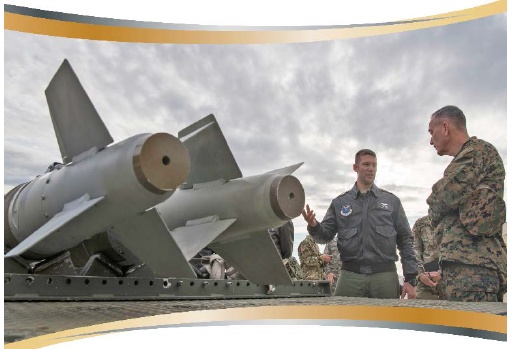
Marine Corps General Joe Dunford, chairman of the Joint Chiefs of Staff, meets with the crew of a B-52H at Minot Air Force Base, N.D., November 2, 2016. (DoD photo)
The triad must be considered as a whole because it functions as a whole, with each leg essential to overall effectiveness. As Secretary of Defense Mattis concluded regarding deterrence requirements and the triad, "I also have looked at – I have questioned the triad, and I cannot solve the deterrent problem reducing it from a triad. If I want to send the most compelling message, I have been persuaded that the triad in its framework is – is the right way to go." The triad's synergy and overlapping attributes help ensure the enduring survivability of our deterrence capabilities against attack and our capacity to hold a range of adversary targets at risk throughout a crisis or conflict. Eliminating any leg of the triad would greatly ease adversary attack planning and allow an adversary to concentrate resources and attention on defeating the remaining two legs.
The U.S. nuclear triad provides key nuclear force attributes required to maintain sufficient diversity and flexibility. These include:
- Survivable. The force and NC3 resilience needed to survive any potential adversary attack and endure throughout crises and conflict.
- Forward Deployable. The mobility and range needed to temporarily or permanently relocate some U.S. nuclear capability to allied or partner territory for needed political or military effect.
- Diverse and Graduated Options. The availability of forces with the spectrum of yield options, weapon types, and delivery options necessary to support the most effective tailoring of strategies across a range of adversaries and contingencies.
- Accurate Delivery. The precision needed to hold adversary assets at risk while minimizing unintended effects.
- Penetrating. The capacity to counter active and passive defenses, including hardened and buried facilities, to pose credible deterrent threats and achieve military objectives with high confidence.
- Responsive. The capacity to deploy and employ forces as promptly as is necessary to pose credible threats.
- Diversity of Ranges. The availability of forces with a spectrum of range options necessary to support the most effective tailoring of strategies.
- Diversity of Trajectories. The capacity to locate forces at multiple geographical locations and with multiple flight profiles to complicate adversary active and passive defense planning.
- Visible. The capacity to display national will and capabilities as desired for signaling purposes throughout crisis and conflict.
- Weapon Reallocation. The capacity to change target information quickly to enable adaptive planning and effective employment.
Together with effective NC3, these force attributes provide the flexible and resilient capabilities needed to support four essential functions:
- Provide survivable, responsive capabilities to ensure adversaries do not attempt a disarming first strike;
- Demonstrate resolve through the positioning of forces, messaging, and flexible response options;
- Ensure the U.S. can respond to a broad range of contingencies with tailored options; and
- Mitigate the risk of a technological failure or adversary breakthrough while providing adaptability to changes in the security environment.
THE THREE LEGS OF THE STRATEGIC NUCLEAR TRIAD
Sea-Based Deterrent Force
The United States currently operates OHIO-class SSBNs equipped with Trident II (D5) SLBMs to provide its sea-based deterrent force. Ballistic missile submarines are the most survivable leg of the triad. When on patrol, SSBNs are, at present, virtually undetectable, and there are no known, near-term credible threats to the survivability of the SSBN force. Nevertheless, we will continue to hedge against the possibility that advances in antisubmarine warfare could make the SSBN force less survivable in the future.
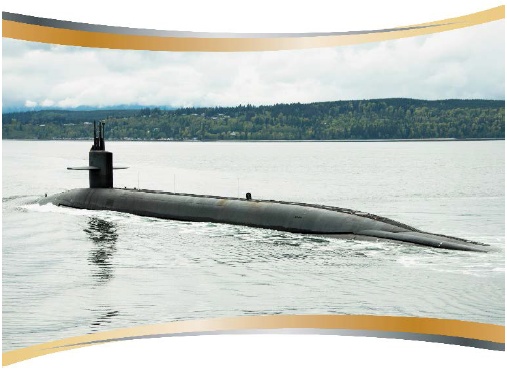
The OHIO-class ballistic-missile submarine USS Kentucky (SSBN 737) transits the Hood Canal as the boat returns to Naval Base Kitsap-Bangor following the boat's first strategic deterrent patrol since 2011. (U.S. Navy photo)
SLBMs also possess a number of other needed attributes. Their intercontinental range and constant readiness allows them to hold targets at risk throughout Eurasia from their launch areas in the Atlantic and Pacific oceans. They are equipped with highly accurate, high-yield warheads, which enhance their ability to hold many types of targets at risk. SLBMs are also prompt. Traveling at hypersonic speed, SLBMs can reach their targets quickly after launch. The SSBN force can upload additional warheads if necessary, contributing to the U.S. hedge capacity.
Finally, SSBNs are highly mobile. They can demonstrate U.S. nuclear presence and commitment for deterrence and assurance purposes via foreign port calls if desired.
The first OHIO-class SSBN entered service in 1981 and the others entered service through the late 1990s. It was originally designed for a 30-year service life and was subsequently extended to 42 years, the longest of any submarine in U.S. history. The D5 SLBM was first deployed in 1990, and its service life is being extended to run through the end of the last OHIO-class SSBN's lifetime in 2042. The OHIO-class cannot be extended further. In coming decades, advances in adversary anti-submarine warfare and missile defense capabilities could challenge the effectiveness of current SSBN and SLBM systems.
Land-Based Deterrent Force
The ICBM force consists of 400, single-warhead Minuteman III ICBMs deployed in 450 underground silos dispersed across several states. These ICBMs are the most responsive leg of the triad because they are in constant readiness and communication can be achieved most expeditiously. This readiness helps preclude a potentially destabilizing rush to alert in a crisis.

An unarmed Minuteman III intercontinental ballistic missile during an operational test at 2:10 a.m. Pacific Daylight Time Wednesday, Aug. 2, 2017, at Vandenberg Air Force Base, Calif. (U.S. Air Force photo)
The ICBM force is highly survivable against any but a large-scale nuclear attack. To destroy U.S. ICBMs on the ground, an adversary would need to launch a precisely coordinated attack with hundreds of high-yield and accurate warheads. This is an insurmountable challenge for any potential adversary today, with the exception of Russia. In contrast, in the absence of our ICBM force, a large proportion of our strategic nuclear triad, including SSBNs in port and non-alert bombers, could be subject to an attempted nuclear first strike involving a relatively small number of nuclear weapons.
The capability to launch ICBMs promptly means that no adversary can be confident in its ability to destroy them prior to launch. This option contributes to deterrence of a nuclear first strike attack. The United States will continue to maintain open-ocean targeting of its strategic nuclear forces day-to-day as a confidence and security building measure. In addition, similar to SLBMs, we will act to ensure that the ICBM force remains effective despite potential advances in adversary ballistic missile defenses.
The ICBM force has high-yield, accurate weapons and intercontinental range, enabling it to hold at risk targets throughout Eurasia. It also is prompt and can reach any target in 30 minutes or less. In addition, a portion of the ICBM force can be uploaded if there is a need to do so–a capability that contributes to our hedging capacity.
The Minuteman III ICBM was first deployed in 1970, with a planned 10-year service life. A series of life extension programs have kept Minuteman III viable, but component aging and inventory attrition are rapidly driving it to the end of its sustainability. From 2002– 2012, Minuteman III underwent a life extension program intended to maintain its viability to 2030. By that time, its 60 years of operation will make it the oldest deployed strategic ballistic missile in the world. The Minuteman III service life cannot be extended further. In addition, Minuteman III will have increasing difficulty penetrating future adversary defenses.
Air-Based Deterrent Force
Heavy bombers are the most flexible and visible leg of the triad. The air leg consists of 46 nuclear capable B-52H and 20 nuclear capable B-2A "stealth" strategic bombers supported by a fleet of Air Force refueling aircraft. While these bombers and air refueling aircraft are not maintained on day-to-day alert, as they were until 1992, they can be alerted and dispersed, improving their pre-launch survivability. Bombers and DCA can also be forward deployed to help deter regional aggression and assure distant allies.
Unlike ICBMs or SLBMs, bombers typically require hours to reach their targets. The longer flight times and ability to recall bombers in flight contribute to their flexibility. Flights abroad display U.S. capabilities and resolve, providing effective signaling for deterrence and assurance, including in times of tension. Bombers can be refueled in flight, giving them virtually unlimited range and endurance. In recent years, B-52 and B-2A bombers have carried out Bomber Assurance and Deterrence missions, including nonstop, round-trip flights from the continental United States to the Korean peninsula.

Air Force Captain flies a B-52H Stratofortress during a training mission over North Dakota, January 31, 2017. (Air Force photo)
Bombers can carry a variety of nuclear weapons with diverse attributes that contribute to the flexibility valuable for deterrence in different circumstances. The gravity bombs carried by B-2A bombers and the ALCMs carried by B-52H bombers provide multiple yield options. In addition, the B83-1 and B61-11 can hold at risk a variety of protected targets. As a result, both will be retained in the stockpile, at least until there is sufficient confidence in the B61-12 gravity bomb that will become available in 2020.
The bombers also play a critical role in the U.S. hedging strategy. Their significant payload capacity provides the ability to upload additional weapons, in particular stand-off cruise missiles, in response to possible geopolitical surprises such as adversary nuclear "breakout" scenarios. Similarly, the upload potential of the U.S. bomber force provides an important hedge against programmatic risk in the strategic replacement programs.
The B-2A bomber is now the only long-range, nuclear capable U.S. aircraft that can penetrate advanced air defenses. Beginning in 1982, our B-52H bombers were equipped with ALCMs in response to steady advances in adversary air defense systems. Armed with ALCMs, the B-52H can stay outside adversary air defenses and remain effective. The ALCM, however, is now more than 25 years past its design life and faces continuously improving adversary air defense systems. Life extension programs (LEPs) are underway to ensure the ALCM can be maintained until its replacement, the Long-Range Stand-Off (LRSO) cruise missile, becomes available.
Non-Strategic Nuclear Weapons
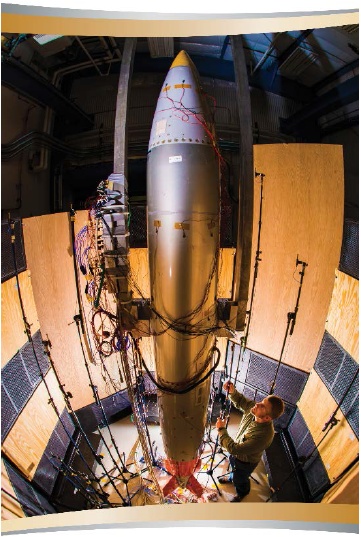
Sandia National Laboratory mechanical engineer adjusts a microphone for an acoustic text on a B-61-12 system.
During the Cold War, the United States possessed large numbers and a wide range of non-strategic nuclear weapons, also known as theater or tactical nuclear weapons. However, we have since retired and dismantled almost all of those weapons. Current U.S. non-strategic nuclear forces consist exclusively of B61 gravity bombs carried by F-15E DCA, supported by responsive air refueling aircraft. Several NATO allies also provide DCA capable of delivering U.S. forward-deployed nuclear weapons. The forthcoming B61-12 gravity bomb will replace earlier versions of the B61, and be available for these DCA beginning in 2021.
U.S. and NATO DCA, together with U.S. gravity bombs, are forward deployed in European NATO countries. Their forward presence contributes significantly to the deterrence of potential adversaries and the assurance of allies. Their presence is a clear deterrence signal to any potential adversary that the United States possesses the forward-deployed capability to respond to escalation. If necessary, the United States has the ability to deploy DCA and nuclear weapons to other regions, such as Northeast Asia.
In sum, U.S. nuclear capabilities include the variety of attributes and flexibility needed to tailor deterrence to a range of potential adversaries and contingencies, assure allies, achieve our objectives if deterrence fails, and hedge against multiple future risks and uncertainties. No single leg of the triad offers all of these attributes, but they are available in the triad as whole, in combination with non-strategic nuclear forces. Relying on life extension programs since the 1980s, and multiple delays in the recapitalization of our nuclear force, has removed all schedule margin between the necessary retirement of our legacy nuclear systems and the fielding of planned replacement systems. Consequently, we will move these forward without delay.
THE DEPARTMENT OF DEFENSE REPLACEMENT PROGRAM
The United States will replace its strategic nuclear triad and sustain the warheads it carries – there is no higher priority for national defense. DoD and DOE will prioritize and fund their respective nuclear delivery system and warhead programs to remain on schedule for synchronized delivery, and they will seek opportunities to accelerate programs where cost effective.
The United States has a two-pronged approach to sustaining the legacy nuclear systems to the extent practicable and to begin the replacement of retiring, legacy systems by the mid-2020s. We will sustain these systems until the planned replacement systems are fielded.
This two-pronged approach responds to emerging threats and is codified by the 2017 National Defense Authorization Act, which directs that, "in support of a strong and credible nuclear deterrent, the United States must–(A) maintain a nuclear force with a diverse, flexible range of nuclear yield and delivery modes that are ready, capable, and credible; and (B) afford the highest priority to the modernization of the nuclear triad, dual-capable aircraft, and related command and control elements."
The Sea-Based Deterrent Force
The COLUMBIA-class program will deliver a minimum of 12 SSBNs to replace the current OHIO fleet and is designed to provide required capabilities for decades. The first COLUMBIA-class SSBN will become operational in 2031. COLUMBIA will include a number of technological features and preserve the flexibility to upgrade to ensure the fleet remains survivable.
Under present building and fielding plans, the number of SSBNs available for deployment will reduce to ten during the 2030s as the OHIO SSBN retires and the COLUMBIA completes production. During the period of fielding COLUMBIA, there will be little-to-no margin for adjusting to an unforeseen event that would force an SSBN into unscheduled maintenance or early retirement. Thus, the United States will ensure that the COLUMBIA program stays on schedule and will continue to ensure that the OHIO SSBN remains operationally effective and survivable until replaced. Given the need to retire the OHIO at 42 years, there is no schedule margin for delay without degrading the critical attributes that the sea-based leg of the triad provides.
We will place similar emphasis on the timely replacement of the D5 SLBM. The D5 SLBM is in the early stages of a life extension that will allow it to be deployed until 2042 on both OHIO and COLUMBIA SSBNs. The Navy will begin studies in 2020 to define a cost-effective, credible, and effective SLBM that we can deploy throughout the service life of the COLUMBIA SSBN.
ICBMs
To sustain the ICBM's critical contributions to the triad, the United States must and will begin fielding its replacement, the Ground-Based Strategic Deterrent (GBSD), on time in 2029. The GBSD program will modernize 450 ICBM launch facilities to support fielding 400 ICBMs to replace the retiring Minuteman III after six decades or more of service. This will provide an ICBM system effective for decades into the future.
Strategic Bombers and Air-Delivered Weapons
The United States will sustain and modernize the B-52H and B-2A to ensure they remain effective into the future. Given the continuing proliferation and improvement of adversary air defense capabilities and the continued aging of the B-52H, the ALCM, and the B-2A, the United States has initiated a program to develop and deploy the next-generation bomber, the B-21 Raider. The B-21 Raider will first supplement, and eventually replace elements of the conventional and nuclear-capable bomber force beginning in the mid-2020s.
The replacement for the aging ALCM – the LRSO – is a modern air-launched cruise missile. The LRSO program will maintain into the future our bomber capability to deliver standoff weapons that can penetrate and survive advanced integrated air defense systems, thus holding targets at risk anywhere on Earth.
Arming our force of strategic bombers with LRSO is critical to ensuring their continuing effectiveness in the face of improving air defenses and to provide a diverse range of response options. The LRSO will enable the B-52H to remain an effective part of the nuclear-capable bomber force and preserve upload potential as a key hedge against unforeseen technical and geopolitical challenges. The B-21 will be able to deliver both gravity bombs and the LRSO, the latter supporting the long-term effectiveness of the bomber leg. Crucial to the success of the heavy bomber force is a viable aerial refueling capability, which also needs recapitalization.
The United States is also incorporating nuclear capability onto the F-35, to be used by the United States and NATO allies, as a replacement for the current aging DCA. Improved DCA readiness and the arrival of the F-35, a "fifth generation aircraft," in conjunction with the ongoing B61-12 gravity bomb LEP, will preserve the DCA contribution to regional deterrence stability and assurance. In parallel with its warhead LEP, the B61-12 will be equipped with a guidance tail kit to sustain the military capability of existing B61 variants. As is the case with the sustainment and replacement programs necessary to maintain the triad, the programs supporting the DCA mission must be completed on time.
If this planned triad and DCA replacement program experiences delays, or if existing systems reach obsolescence earlier than expected, fielded systems will age out before replacements are available and the United States will face potentially significant gaps in its diverse and flexible capabilities needed to deter, assure, achieve objectives if deterrence fails, and hedge against future uncertainty. Delays to the SSBN and SLBM replacement programs would reduce the survivability and flexibility of U.S. nuclear capabilities and challenge our ability to maintain rough parity with Russian strategic deployments, even at the reduced levels set by New START. Delays in the GBSD program, accompanied by a rapid age-out of our ICBM force, would dramatically reduce the scale of attack required for an adversary to threaten much of the U.S. deterrent forces in a first-strike attack. Delays in the B-21 bomber program or associated bomber weapons would reduce the ability of our strategic forces to penetrate adversary air defenses, limit the diversity of our response options, and compromise our ability to send the visible deterrence and assurance signals for which strategic bombers are particularly well suited.
FLEXIBLE AND SECURE NUCLEAR CAPABILITIES: AN AFFORDABLE PRIORITY
"What we want to do is to deter. Nobody wants to have a war. The only thing more expensive than deterrence is actually fighting a war, and the only thing more expensive than fighting a war is fighting one and losing."
U.S. Army Chief of Staff, General Mark A. Milley, 2016
Throughout past decades, senior U.S. officials have emphasized that the highest priority of the Department of Defense is deterring nuclear attack and, therefore, sustaining the nuclear capabilities necessary to deter. More recently, Secretary of Defense Mattis, former Secretary of Defense Carter, and the Chairman of the Joint Chiefs, General Joseph Dunford, have all emphasized the priority of the nuclear deterrence mission and the necessity of our nuclear sustainment and replacement programs.
While estimates of the cost to sustain and replace U.S. nuclear capabilities vary, based on the timeframe considered and how they account for various elements of the program, even the highest of these projections place the highpoint of the future cost at approximately 6.4 percent of the current DoD budget. Maintaining and operating our current aging nuclear forces now requires between two and three percent of the DoD budget, and the replacement program to rebuild the triad for decades of service will peak for several years at only approximately four percent beyond the existing sustainment level of spending. This 6.4 percent of the current DoD budget required for the long-term program represents less than one percent of today's overall federal budget. As indicated by Figure 3, this level of spending compares favorably to the 10.6 percent of the DoD budget required during the last such investment period in the 1980s, which at the time was almost 3.7 percent of the federal budget, and the 17.1 percent of the DoD budget required in the early 1960s.
DOD NUCLEAR ENTERPRISE FUNDING
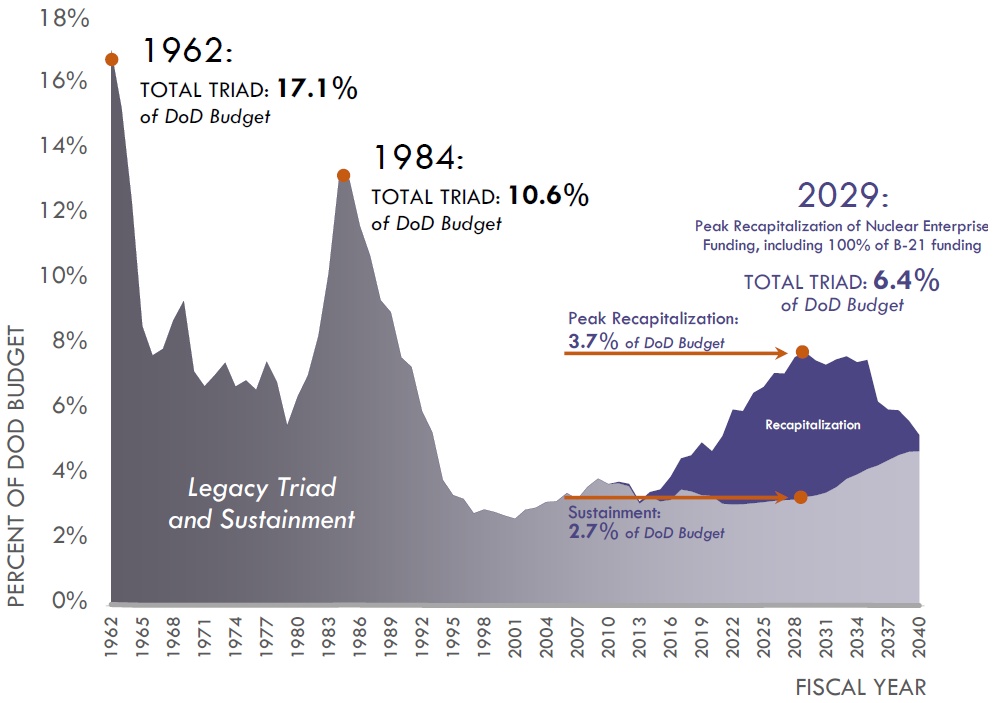
Figure 3. Cost of DoD Nuclear Force Replacement
Data provided by DoD
The projected DoD costs of sustaining and replacing the nuclear capabilities needed to support U.S. national security strategy, while substantial, are moderate in historical terms and represent a small fraction of the DoD budget. Given the criticality of effective U.S. nuclear deterrence to the assurance of allies, and, most importantly, the safety of the American people, there is no doubt that these programs are both necessary and affordable.
ENHANCING DETERRENCE WITH NON-STRATEGIC NUCLEAR CAPABILITIES
Existing elements of the nuclear force replacement program predate the dramatic deterioration of the strategic environment. To meet the emerging requirements of U.S. strategy, the United States will now pursue select supplements to the replacement program to enhance the flexibility and responsiveness of U.S. nuclear forces. It is a reflection of the versatility and flexibility of the U.S. triad that only modest supplements are now required in this much more challenging threat environment.
RUSSIA'S NON-STRATEGIC NUCLEAR CHALLENGE
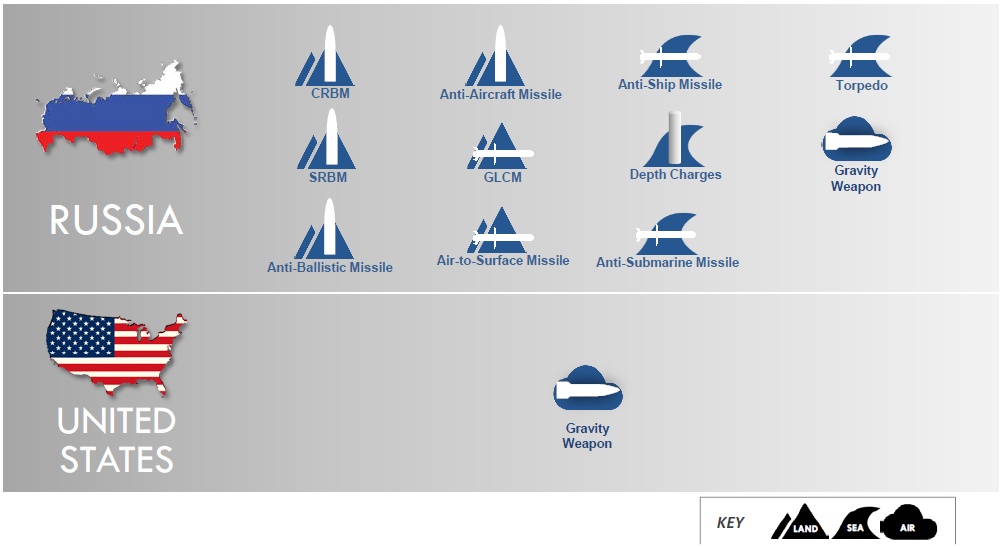
Figure 4. Russia's Non-Strategic Nuclear Challenge
Data provided by the DoD
Russia is modernizing an active stockpile of up to 2,000 non-strategic nuclear weapons, including those employable by ships, planes, and ground forces. These include air-to-surface missiles, short range ballistic missiles, gravity bombs, and depth charges for medium-range bombers, tactical bombers, and naval aviation, as well as anti-ship, anti-submarine, and anti-aircraft missiles and torpedoes for surface ships and submarines, a nuclear ground-launched cruise missile in violation of the 1987 INF Treaty, and Moscow's antiballistic missile system.
These supplements will enhance deterrence by denying potential adversaries any mistaken confidence that limited nuclear employment can provide a useful advantage over the United States and its allies. Russia's belief that limited nuclear first use, potentially including low-yield weapons, can provide such an advantage is based, in part, on Moscow's perception that its greater number and variety of non-strategic nuclear systems provide a coercive advantage in crises and at lower levels of conflict. Recent Russian statements on this evolving nuclear weapons doctrine appear to lower the threshold for Moscow's first-use of nuclear weapons. Russia demonstrates its perception of the advantage these systems provide through numerous exercises and statements. Correcting this mistaken Russian perception is a strategic imperative. North Korea is illicitly developing a range of strategic and non-strategic nuclear systems to threaten the United States, allies, and partners. It may mistakenly perceive that these systems, when coupled with the threat of a strategic nuclear attack against the United States, would provide advantageous nuclear escalation options in crises or conflict.

U.S. Air Force F-35A Lightning IIs assigned to Hill Air Force Base, Utah taxi at Kunsan Air Base, Republic of Korea, November 27, 2017. (U.S. Air Force photo)
To address these types of challenges and preserve deterrence stability, the United States will enhance the flexibility and range of its tailored deterrence options. U.S. strategy does not require non-strategic nuclear capabilities that quantitatively match or mimic Russia's more expansive arsenal. Rather, the United States will maintain a spectrum of capabilities sized and postured to meet U.S. needs, and particularly to ensure that no adversary under any circumstances can perceive an advantage through limited nuclear escalation or other strategic attack.
For decades, the United States has deployed low-yield nuclear options to strengthen deterrence and assurance. Expanding flexible U.S. nuclear options now, to include low-yield options, is important for the preservation of credible deterrence against regional aggression. To be clear, this is not intended to enable, nor does it enable, "nuclear war-fighting." Nor will it lower the nuclear threshold. Rather, expanding U.S. tailored response options will raise the nuclear threshold and help ensure that potential adversaries perceive no possible advantage in limited nuclear escalation, making nuclear weapons employment less likely.
Consequently, the United States will maintain, and enhance as necessary, the capability to forward deploy nuclear bombers and DCA around the world. We are committed to upgrading DCA with the nuclear-capable F-35 aircraft. We will work with NATO to best ensure–and improve where needed–the readiness, survivability, and operational effectiveness of DCA based in Europe.
Additionally, in the near-term, the United States will modify a small number of existing SLBM warheads to provide a low-yield option, and in the longer term, pursue a modern nuclear-armed sea-launched cruise missile (SLCM). Unlike DCA, a low-yield SLBM warhead and SLCM will not require or rely on host nation support to provide deterrent effect. They will provide additional diversity in platforms, range, and survivability, and a valuable hedge against future nuclear "break out" scenarios.
DoD and NNSA will develop for deployment a low-yield SLBM warhead to ensure a prompt response option that is able to penetrate adversary defenses. This is a comparatively low-cost and near-term modification to an existing capability that will help counter any mistaken perception of an exploitable "gap" in U.S. regional deterrence capabilities. Doing so will not increase the number of deployed U.S. ballistic missile warheads, as the low-yield weapons will replace higher-yield weapons currently deployed.
In addition to this near-term step, for the longer term the United States will pursue a nuclear-armed SLCM, leveraging existing technologies to help ensure its cost effectiveness. SLCM will provide a needed non-strategic regional presence, an assured response capability, and an INF-Treaty compliant response to Russia's continuing Treaty violation. If Russia returns to compliance with its arms control obligations, reduces its non-strategic nuclear arsenal, and corrects its other destabilizing behaviors, the United States may reconsider the pursuit of a SLCM.
Indeed, U.S. pursuit of a SLCM may provide the necessary incentive for Russia to negotiate seriously a reduction of its non-strategic nuclear weapons, just as the prior Western deployment of intermediate-range nuclear forces in Europe led to the 1987 INF Treaty. As then Secretary of State George P. Shultz stated, "If the West did not deploy Pershing II and cruise missiles, there would be no incentive for the Soviets to negotiate seriously for nuclear weapons reductions."
In the 2010 NPR, the United States announced the retirement of its previous nuclear-armed SLCM, which for decades had contributed to deterrence and the assurance of allies, particularly in Asia. Given the increasing need for flexible and low-yield options to strengthen deterrence and assurance, we will immediately begin efforts to restore this capability by initiating a capabilities study leading to an Analysis of Alternatives (AoA) for the rapid development of a modern SLCM. It will strengthen the effectiveness of the sea-based nuclear deterrence force and is complementary to LRSO, but cannot substitute for it because LRSO is required to sustain an effective air leg of the triad.
These supplements to the planned nuclear force replacement program– a modified SLBM warhead and modern SLCM–are prudent options for enhancing the flexibility and diversity of U.S. nuclear capabilities to help address emerging deterrence requirements in the near term and beyond. They are compliant with all treaties and agreements, and together, they will: provide a more diverse set of characteristics greatly enhancing our ability to tailor deterrence and assurance; expand the range of credible U.S. options for responding to nuclear or non-nuclear strategic attack; and, enhance deterrence by signaling to potential adversaries that their concepts of coercive, limited nuclear escalation offer no exploitable advantage.
NUCLEAR COMMAND, CONTROL, AND COMMUNICATIONS (NC3) MODERNIZATION
"We have to modernize the entire architecture. And so, as you see the modernization plans coming in; make sure, number one, it's the 21st century information architecture."
Commander, United States Strategic Command, General John Hyten, 4 April 2017
The United States must have an NC3 system that ensures command and control of U.S. nuclear forces at all times, even under the enormous stress of a nuclear attack. NC3 capabilities must assure the integrity of transmitted information and possess the resiliency and survivability necessary to reliably overcome the effects of adversary nuclear attack. The NC3 architecture is essential for deterrence and enables a response if deterrence fails.

The Advanced Extremely High Frequency, or AEHF, system provides survivable, global, secure, protected and jam-resistant communications for high-priority military ground, sea and air assets. (U.S. Air Force photo)
During peacetime and crisis, the NC3 system performs five crucial functions: detection, warning, and attack characterization; nuclear planning; decision-making conferencing; receiving Presidential orders; and enabling the management and direction of forces.
Today's NC3 system is a legacy of the Cold War, last comprehensively updated almost three decades ago. It includes interconnected elements composed of warning satellites and radars; communications satellites, aircraft, and ground stations; fixed and mobile command posts; and the control centers for nuclear systems.
- Warning systems include fixed, terrestrial phased array warning radars; the Defense Support Program (DSP) system and its replacement, the Space Based Infrared System (SBIRS); and the U.S. Nuclear Detonation Detection System (USNDS).
- Communications systems include the Military Strategic and Tactical Relay (MILSTAR) satellites and its replacement, the Advanced Extremely High Frequency (AEHF) satellites; a wide variety of ground-based transmission systems across the radio frequency spectrum; and Take Charge and Move Out (TACAMO) relay aircraft.
- The fixed command posts include the National Military Command Center (NMCC) and the U.S. Strategic Command Global Operations Center. Fixed command posts also include linkages to U.S. forward-deployed forces in USEUCOM and elsewhere. Mobile command posts include the E4B National Airborne Operations Center (NAOC), the E6B Airborne Command Post (ABNCP), and ground mobile systems.
- Control centers for nuclear systems are in ICBM Launch Control Centers, on SSBNs, and aboard bomber aircraft.
While once state-of-the-art, the NC3 system is now subject to challenges from both aging system components and new, growing 21st century threats. Of particular concern are expanding threats in space and cyber space, adversary strategies of limited nuclear escalation, and the broad diffusion within DoD of authority and responsibility for governance of the NC3 system, a function which, by its nature, must be integrated.
Expanding Threats. Space is no longer a sanctuary and orbital space is increasingly congested, competitive, and contested. A number of countries, particularly China and Russia, have developed the means to disrupt, disable, and destroy U.S. assets in space. Because space is no longer an uncontested domain, U.S. NC3 space systems need to be more survivable, defendable, and provide resilient capabilities.
The emergence of offensive cyber warfare capabilities has created new challenges and potential vulnerabilities for the NC3 system. Potential adversaries are expending considerable effort to design and use cyber weapons against networked systems. While our NC3 system today remains assured and effective, we are taking steps to address challenges to network defense, authentication, data integrity, and secure, assured, and reliable information flow across a resilient NC3 network.
Nuclear Environment. Because potential adversaries are emphasizing the employment of limited nuclear options, our NC3 system must be resilient in the context of adversary limited nuclear strikes. The U.S. leadership, including Combatant Commanders, must be able to communicate and share information across networked command and control systems, and to integrate nuclear and non-nuclear military planning and operations in the context of adversary nuclear employment.
Modernizing the NC3 System
In light of the critical need to ensure our NC3 system remains survivable and effective in crisis and conflict, the United States will pursue a series of initiatives to strengthen NC3 and address 21st century needs and challenges.
Strengthen Protection Against Space-based Threats. The United States will ensure space assets are agile and resilient, thereby deterring and if necessary overcoming attempts to extend conflict into space. The United States will enhance the training of operational space forces to ensure that we are prepared to successfully achieve mission objectives against the range of 21st century threats.
Strengthen Protection Against Cyber Threats. The United States will protect NC3 components against current and future cyber threats and ensure the continuing availability of U.S.-produced information technology necessary for the NC3 system.
Enhance Integrated Tactical Warning and Attack Assessment. The United States will develop a future architecture which will include modernized SBIRS satellites and integrate missile defense sensors to maximize warning time. The United States will also continue to transition the DSP system to SBIRS and enhance ground-based radars. The upgraded SBIRS constellation will include six satellites supported by the existing DSP architecture to enhance the survivability of U.S. satellites. Additionally, we will continue to sustain and upgrade the USNDS to support accurate attack assessment.

Missile Technician 3rd Class, Senior Chief Missile Technician and Machinist's Mate, all assigned to the Ohio-class ballistic-missile submarine USS Alaska (SSBN 732), operate the controls of the dive simulator at the Trident Training Facility. (U.S. Navy photo)
Improve Command Posts and Communications Links. The United States will upgrade and modernize critical NC3 airborne systems, including the NAOC, the ABNCP, and the TACAMO aircraft. We will also develop planning systems at all fixed and mobile sites to enhance command and control, and field modernized communication transmitters and terminals across the NC3 system to better ensure assured, reliable, and resilient communications at all levels of the nuclear force.
Advance Decision Support Technology. The United States will continue to adapt new technologies for information display and data analysis to improve support for Presidential decision making and senior leadership consultations.
Integrate Planning and Operations. The United States will improve the capability of our Combatant Commands to communicate and share information across networked command and control systems in the context of adversary nuclear employment. U.S. forces will strengthen their ability to integrate nuclear and non-nuclear military operations to deter limited nuclear escalation and non-nuclear strategic attacks. Finally, Combatant Commands will plan, organize, train, and exercise for this mission.
Reform Governance of the Overall NC3 System. The United States will improve its NC3 governance to ensure DoD is properly organized to maintain a fully capable NC3 system to address current and future environments. To address this challenge, the Chairman of the Joint Chiefs of Staff in consultation with key DoD stakeholders will deliver to the Secretary of Defense no later than May 1, 2018, a plan to reform NC3 governance to ensure its effective functioning and modernization.
VIII. NUCLEAR WEAPONS INFRASTRUCTURE
"NNSA's ability to achieve its vital national security missions is dependent on safe and reliable infrastructure. If not appropriately-addressed, the age and condition of NNSA's infrastructure will put NNSA's missions, safety of its workers, the public, and the environment at risk."
NNSA Administrator, Frank Klotz, 2017
An effective, responsive, and resilient nuclear weapons infrastructure is essential to the U.S. capacity to adapt flexibly to shifting requirements. Such an infrastructure offers tangible evidence to both allies and potential adversaries of U.S. nuclear weapons capabilities and can help to deter, assure, hedge against adverse developments, and discourage adversary interest in arms competition.
The NNSA is responsible for the Nation's nuclear weapons infrastructure. DoD generates military requirements for the nuclear warheads to be carried on delivery platforms. The NNSA oversees the assessment, design development, production, test, and research programs that respond to DoD warhead requirements.
The infrastructure consists of people with the requisite skills (e.g., scientists, engineers, production personnel) and the associated experimental and industrial facilities that:
- Sustain today's nuclear stockpile and ensure its continued safety, security, and effectiveness;
- Extend the life of a select sub-set of nuclear warheads, and design, develop, and produce nuclear weapons as needed for today and into the future;
- Assess and certify annually whether the safety and reliability of the future nuclear stockpile can be assured in the absence of underground nuclear testing, and, as a safeguard, maintain a nuclear test capability;
- Maintain the capability to design, develop and produce nuclear warheads with new or different military capabilities if required in the future; and
- Provide an effective response to technical problems with a warhead or to adverse geopolitical developments that call for force augmentation.

Machinists at Lawrence Livermore National Laboratory use a state-of-the-art hydraulic press needed for W80-4 work. (Photo provided by NNSA)
In addition, the scientists, engineers, and production personnel of the nuclear infrastructure support nuclear arms control, threat reduction, naval nuclear propulsion, non-proliferation efforts, assessment of foreign nuclear weapons programs, nuclear counterterrorism, and emergency response.
The main challenge to an effective and resilient infrastructure is the need to maintain design, development, manufacturing, and testing capabilities during the lengthy periods of time between rebuilding cycles to ensure the enduring health of the infrastructure. During the Cold War, the United States carried out an intensive and balanced program on roughly a five-year cycle. The last new, modern warhead development program (the W88) was completed by the early 1990s.
We are now in the early stages of a comprehensive warhead sustainment program. To provide the required strategic vision needed to inform critical warhead modernization investments, the DoD and DOE Nuclear Weapons Council approved a strategic plan. This plan describes a current and future path for the nuclear warhead stockpile to meet deterrence, assurance, and technical hedging requirements.
The U.S. must have the ability to maintain and certify a safe, secure, and effective nuclear arsenal. Synchronized with DoD replacement programs, the United States will sustain and deliver on-time the warheads needed to support both strategic and non-strategic nuclear capabilities by:
- Completing the W76-1 LEP by Fiscal Year (FY) 2019;
- Completing the B61-12 LEP by FY2024;
- Completing the W88 alterations by FY2024;
- Synchronizing NNSA's W80-4 life extension, with DoD's LRSO program and completing the W80-4 LEP by FY2031;
- Advancing the W78 warhead replacement one year to FY19 to support fielding on GBSD by 2030 and investigate the feasibility of fielding the nuclear explosive package in a Navy flight vehicle;
- Sustaining the B83-1 past its currently planned retirement date until a suitable replacement is identified; and,
- Exploring future ballistic missile warhead requirements based on the threats and vulnerabilities of potential adversaries, including the possibility of common reentry systems between Air Force and Navy systems.

Detector for Advanced Neutron Capture Experiments at Los Alamos Neutron Science Center. (Photo provided by NNSA)
Over the past several decades, the U.S. nuclear weapons infrastructure has suffered the effects of aging and underfunding. Over half of NNSA's infrastructure is over 40 years old, and a quarter dates back to the Manhattan Project era. All previous NPRs highlighted the need to maintain a modern nuclear weapons infrastructure, but the United States has fallen short in sustaining a modern infrastructure that is resilient and has the capacity to respond to unforeseen developments. There is now no margin for further delay in recapitalizing the physical infrastructure needed to produce strategic materials and components for U.S. nuclear weapons.
In 2008, the Secretary of Defense and Secretary of Energy released a joint report stating, "While the service lives of existing warhead types are being extended through refurbishment, at present the United States does not have the ability to produce new nuclear weapons." While North Korea can illicitly produce nuclear warheads, the United States does not have a sustained plutonium pit manufacturing capability needed to avoid stockpile age-out, support life extension programs, and prepare for future uncertainty. Plutonium pits are critical components of every nuclear warhead, with nearly all current stockpile pits having been produced from 1978–1989. Today, the U.S. capability to produce plutonium pits is limited to research and development pits unsuitable for stockpile use. To avoid age-related risks, DoD requires NNSA to produce at least 80 plutonium pits per year by 2030, and to sustain the capacity for future LEPs and follow-on programs.
U.S. production of tritium, a critical strategic material for nuclear weapons, is now insufficient to meet the forthcoming U.S. nuclear force sustainment demands, or to hedge against unforeseen developments. Programs are planned, but not yet fully funded, to ease these critical production shortfalls. In the absence of sustained support for these programs, including a marked increase in the planned production of tritium in the next few years, our nuclear capabilities will inevitably atrophy and degrade below requirements.
The U.S. is also unable to produce or process a number of other critical materials, including lithium and enriched uranium. For instance, the United States largely relies on dismantling retired warheads to recover lithium to sustain and produce deployable warheads. This may be inadequate to support the nuclear force replacement program and any supplements to it.

Secretary Perry meets with Yukiya Amano, Director General of IAEA on March 20, 2017 at the Department of Energy. (Photo provided by DOE)
Past assumptions that our capability to produce nuclear weapons would not be necessary and that we could permit the required infrastructure to age into obsolescence have proven to be mistaken. It is now clear that the United States must have sufficient research, design, development, and production capacity to support the sustainment and replacement of its nuclear forces. To meet these needs, the United States must resolve the current significant infrastructure funding shortfalls over the next five years.
To remain postured to address challenges that may emerge, the United States needs the flexibility to hedge against future risks. Consequently, NNSA will explore approaches for rapid prototyping, develop options for modifying warheads to increase flexibility and responsiveness, examine the potential for retired warheads and components to augment the future hedge stockpile, and survey past and extant warhead designs to better understand what can be certified without resuming full-scale nuclear testing. An additional measure for needed flexibility is to reduce the time required to design, develop, and initially produce a warhead, from a decision to enter full-scale development.
Along with its nuclear weapon development and production infrastructure, NNSA will maintain the capability to resume underground nuclear explosive testing if called upon to do so. The United States will not seek Senate ratification of the Comprehensive Nuclear Test Ban Treaty, but will continue to observe a nuclear test moratorium that began in 1992. This posture was adopted with the understanding that the United States must remain ready to resume nuclear testing if necessary to meet severe technological or geopolitical challenges.
The nuclear weapons infrastructure depends on a highly skilled, world-class workforce from a broad array of disciplines, including engineering, physical sciences, mathematics, and computer science. Maintaining the necessary critical skills and retaining personnel with the needed expertise requires sufficient opportunities to exercise those skills. Should a technical or geopolitical development demand a new nuclear weapon, it is crucial that the nuclear weapons workforce possess the skills and the knowledge needed to design, develop, and manufacture warheads of different design in a timely manner.
Yet, the United States, unlike potential adversaries, has not executed a new nuclear weapon program for decades. Ongoing work involves life extension programs for existing weapons. To ensure we sustain the necessary skills and knowledge required to take new warhead designs from initial concept through development, prototyping, and plans for certification, NNSA should assess capabilities currently being exercised by: life extension programs, stockpile certification, laboratory directed research and development, and technology maturation. On this basis, NNSA will identify any gaps in the full range of the skills needed to design and develop nuclear weapons. The Stockpile Responsiveness Program that Congress recently instituted with bipartisan support explicitly directs that the United States ensure the responsiveness and flexibility of our nuclear weapons infrastructure. This is an important element of the U.S. hedging strategy because it promises to provide more timely availability of new capabilities if they are needed to meet changes in the security environment.
The United States will pursue initiatives to ensure the necessary capability, capacity, and responsiveness of the nuclear weapons infrastructure and the needed skills of the nuclear enterprise workforce, including the following:
- Pursue a joint DoD and DOE advanced-technology development capability to ensure that efforts are appropriately integrated to meet DoD needs.
- Provide the enduring capability and capacity to produce plutonium pits at a rate of no fewer than 80 pits per year by 2030. A delay in this would result in the need for a higher rate of pit production at higher cost.
- Ensure that current plans to reconstitute the U.S. capability to produce lithium compounds are sufficient to meet military requirements.
- Fully fund the Uranium Processing Facility and ensure availability of sufficient low-enriched uranium to meet military requirements.
- Ensure the necessary reactor capacity to produce an adequate supply of tritium to meet military requirements.
- Ensure continuity in the U.S. capability to develop and manufacture secure, trusted strategic radiation-hardened microelectronic systems beyond 2025 to support stockpile modernization.
- Rapidly pursue the Stockpile Responsiveness Program established by Congress to expand opportunities for young scientists and engineers to advance warhead design, development, and production skills.
- Develop an NNSA roadmap that sizes production capacity to modernization and hedging requirements.
- Retain confidence in nuclear gravity bombs needed to meet deterrence needs.
- Maintain and enhance the computational, experimental, and testing capabilities needed to annually assess nuclear weapons.
Due to underfunding by previous administrations, significant and sustained investments will be required over the coming decade to ensure that NNSA will be able to deliver the nuclear weapons at the needed rate to support nuclear deterrence in the 2030s and beyond.
IX. COUNTERING NUCLEAR TERRORISM
"[W]e must prevent nuclear weapons and materials from coming into the hands of terrorists and being used against us, or anywhere in the world..."
President Donald Trump, August 21, 2017
Nuclear terrorism remains among the most significant threats to the security of the United States, allies, and partners. The Joint Chiefs of Staff, in 2015, emphasized, "Nuclear, chemical, and biological agents pose uniquely destructive threats. They can empower a small group of actors with terrible destructive potential. Thus combatting weapons of mass destruction (WMD) as far from our homeland as possible is a key mission for the U.S. military."
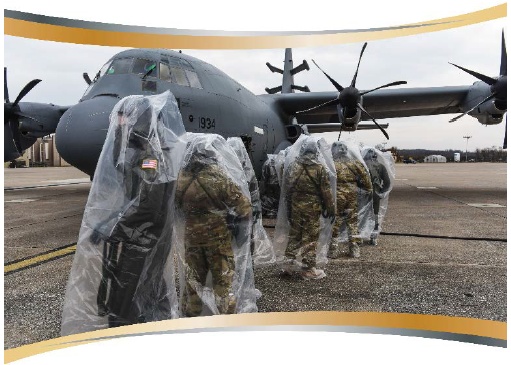
U.S. Airmen from the 193rd Special Operations Squadron, prepare to board an EC-130J Commando Solo aircraft December 2, 2017, at 193rd Special Operations Wing, Middletown, Pennsylvania. (U.S. Air National Guard photo)
U.S. strategy to combat the threat of nuclear terrorism encompasses a wide range of activities that comprise a defense-in-depth against current and emerging dangers. Under this multilayered approach, the United States strives to prevent terrorists from obtaining nuclear weapons or weapons-usable materials, technology, and expertise; counter terrorist efforts to acquire, transfer, or employ these assets; and respond to nuclear incidents, by locating and disabling a nuclear device or managing the consequences of a nuclear detonation. Key U.S. efforts under this strategy include:
- Securing nuclear weapons, materials, related technology, and knowledge to prevent their malicious use.
- Enhancing cooperation with allies, partners, and international institutions to combat nuclear terrorism.
- Deterring state support for nuclear terrorism through advanced forensics and attribution capabilities.
- Strengthening defenses against nuclear terrorism to protect the American people and U.S. interests at home and abroad.
- Enhancing preparedness to mitigate the effects of nuclear incidents.
With the cooperation of overseas partners, the United States has worked for nearly three decades to keep nuclear and radiological materials out of the hands of terrorists. As the number of nuclear facilities and the quantity of nuclear material worldwide continue to increase, we will maintain our focus on reducing the vulnerability of these materials to theft or seizure. We will also decrease the availability of sensitive equipment and technologies on the black market and thereby hinder terrorist access to them.
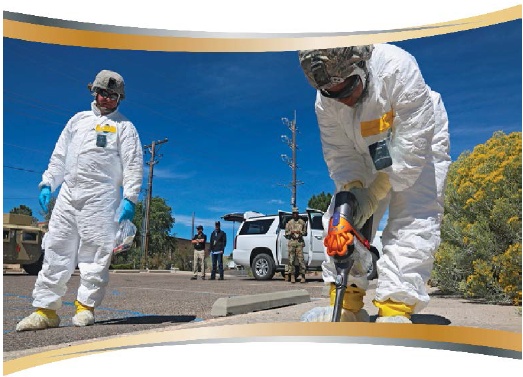
Participants in Prominent Hunt 17-2, an interagency Nuclear Forensics Exercise, held in New Mexico. (Photo provided by NNSA)
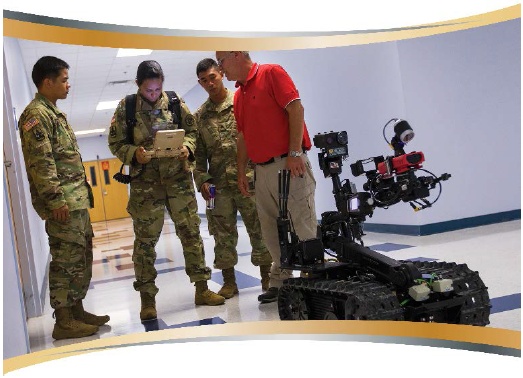
Soldiers from the Hawaii National Guard's 93rd Weapons of Mass Destruction Civil Support Team receive hands-on training with the Talon IV unmanned robot at the Robot Logistics Support Center, in Lexington, Ky., July 26, 2017. (Army photo)
The most effective way to reduce the risk of nuclear terrorism is to secure nuclear weapons and materials at their sources. The United States will continue to work with allies and partners to disrupt proliferation networks and interdict transfers of nuclear materials and related technology. In particular, we will improve coordination with international export-control and law-enforcement agencies to bolster information sharing to detect and interdict nuclear and radiological material. Through collaboration with foreign partners, we will maintain the constellation of radiation detection technologies that have been deployed in 60 countries around the world to thwart the smuggling of nuclear weapons and materials by land, sea, and air. Domestically, we will sustain and build upon the roughly 57,000 radiation detectors operating at U.S. seaports, border crossings, and within the American interior.
As part of this defense-in-depth, the United States will sustain its specialized capabilities to search for, interdict, characterize, and disable nuclear devices. These assets are strategically pre-positioned throughout the country to respond rapidly to nuclear incidents and save American lives. Should an act of nuclear terrorism occur, the United States also maintains advanced nuclear forensics capabilities to identify the source of the material used in a nuclear device, thereby strengthening the deterrence of such an attack. We will continue to improve our ability to attribute the source of a nuclear attack by establishing a nuclear materials archive to store, consolidate, and analyze high-value nuclear materials.
The United States will hold fully accountable any state, terrorist group, or other non-state actor that supports or enables terrorist efforts to obtain or employ nuclear devices. Although the role of U.S. nuclear weapons in countering nuclear terrorism is limited, for effective deterrence our adversaries must understand that a terrorist nuclear attack against the United States or its allies and partners would qualify as an "extreme circumstance" under which the United States could consider the ultimate form of retaliation.
X. NON-PROLIFERATION AND ARMS CONTROL
"In a world with no overarching global authority, rules are only as strong as the willingness of states to follow or enforce them."
Joint Chiefs of Staff, 2016
Effective nuclear non-proliferation and arms control measures can support U.S., allied, and partner security by controlling the spread of nuclear materials and technology; placing limits on the production, stockpiling, and deployment of nuclear weapons; decreasing misperception and miscalculation; and avoiding destabilizing nuclear arms competition. Consequently, the United States will continue its efforts to: 1) minimize the number of nuclear-armed states, including by maintaining credible U.S. extended nuclear deterrence and assurance; 2) deny terrorist organizations access to nuclear weapons, materials, and expertise; 3) strictly control weapons-usable material, related technology, and expertise; and 4) seek arms control agreements that enhance security, and are verifiable and enforceable.
NON-PROLIFERATION AND THE NUCLEAR NON-PROLIFERATION TREATY
The NPT is the cornerstone of the nuclear non-proliferation regime. It provides the formal international legal framework for measures to constrain and deny proliferators and to identify, contain, and sanction transgressors. The Treaty establishes a framework governing peaceful uses of nuclear energy, allowing states to pursue civil nuclear programs under safeguards that help provide transparency and confidence that such programs will not contribute to proliferation. The NPT's positive role in building consensus for non-proliferation enhances international efforts to impose costs on those who would pursue nuclear weapons outside the Treaty. It also contributes to U.S. and international efforts to mitigate threats of nuclear terrorism by helping to safeguard nuclear and radiological material and prevent the spread of sensitive nuclear technologies and expertise.
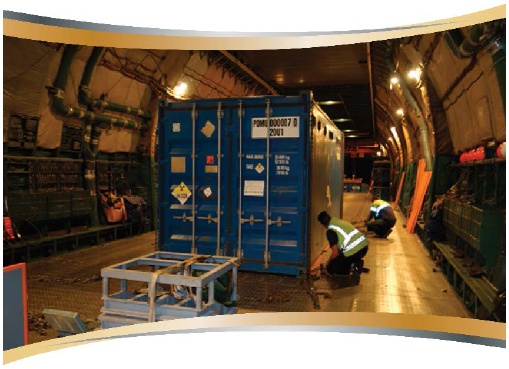
NNSA and the Institute of Nuclear Physics in Kazakhstan collaborate to remove all HEU from the institute's reactor. (Photo provided by NNSA)
The United States remains committed to nuclear non-proliferation, continues to abide by its obligations under the NPT, and will work to strengthen the NPT regime. In addition, the United States will continue to maintain a credible nuclear umbrella extended to over thirty allies and partners. This is essential to meeting their need for nuclear deterrence, while enabling them to forego independent nuclear weapons capabilities. Credible U.S. extended nuclear deterrence will continue to be a cornerstone of U.S. non-proliferation efforts.
Nuclear non-proliferation today faces acute challenges. Most significantly, North Korea is pursuing a nuclear path in direct contravention of the NPT and in direct opposition to numerous U.N. Security Council resolutions. The risk of North Korea employing nuclear weapons or attempting to sell its nuclear technology and expertise is an international problem and the international community must continue to work toward preventing this threat.
Beyond North Korea looms the challenge of Iran. Although the JCPOA may constrain Tehran's nuclear program, Iran retains the ability to produce weapons grade uranium for use in a nuclear weapon if it decides to do so. This, combined with Iran's ongoing missile testing, is a serious concern.
Despite these challenges, the institutions that support the NPT, such as the International Atomic Energy Agency, help identify violations, provide evidentiary support for the imposition of multilateral sanctions, and, as is the case with Iran, establish international monitoring and verification capabilities. Perhaps most importantly, strengthening these institutions and the international safeguards system supports verifiable, durable progress on non-proliferation and potentially further negotiations on nuclear reductions if the security environment permits.

Arizona Army National Guard Soldiers from the 2220th Transportation Company are engulfed by colored smoke after putting on their protective masks during a simulated chemical attack August 5, 2017 at Florence Military Reservation in Florence, Ariz. The Guardsmen conducted nuclear, biological and chemical warfare training which included entering a gas chamber and being exposed to CS tear gas. (U.S. Army National Guard photo)
In continuing support of nuclear non-proliferation, the United States will continue to pursue the political and security conditions that could enable further nuclear reductions. We will work to increase transparency and predictability, where appropriate, to avoid potential miscalculation among nuclear weapons states and other possessor states through strategic dialogues, risk-reduction communications channels, and sharing of best practices related to nuclear weapons safety and security.
To further strengthen the NPT regime, the United States will support initiatives to improve capabilities to detect, deter, and attribute proliferation and use; reduce the vulnerability of nuclear and radiological materials to theft or seizure around the world; and reduce the availability of proliferation-sensitive equipment and technologies through illicit transfers. These activities will reduce potential terrorist access to this equipment and technology. The United States will also support the efforts of multilateral supplier regimes such as the Zangger Committee and the Nuclear Suppliers Group. We will continue to perfect forensics capabilities for attribution purposes by establishing a nuclear materials archive to store, consolidate, and analyze high-value nuclear materials to work in concert with the existing Nuclear Materials Information Program.
Further, the United States remains committed to finding long-term solutions to the technical challenges of verifying nuclear reductions, and therefore will explore new concepts and approaches for this goal, including continued support for the International Partnership for Nuclear Disarmament Verification.
The number of nuclear facilities and the quantities of nuclear materials worldwide continue to increase, with a wide variance in security measures and potential vulnerabilities that could result in terrorist acquisition of nuclear materials. Consequently, the United States will continue to work with allies and partners to disrupt proliferation networks; interdict transfers of WMD-related materials, technology, and expertise; prevent the employment of improvised nuclear devices; attribute responsibility to perpetrators; and mitigate the consequences of WMD employment.
Although the United States will not seek Senate ratification of the Comprehensive Nuclear Test Ban Treaty, it will continue to support the Comprehensive Nuclear Test Ban Treaty Organization Preparatory Committee as well as the related International Monitoring System and the International Data Center, which detect nuclear tests and monitor seismic activity. The United States will not resume nuclear explosive testing unless necessary to ensure the safety and effectiveness of the U.S. nuclear arsenal, and calls on all states possessing nuclear weapons to declare or maintain a moratorium on nuclear testing.
Finally, it is important to recognize that the Nuclear Weapons Ban Treaty, opened for signature at the U.N. in 2017, is fueled by wholly unrealistic expectations of the elimination of nuclear arsenals without the prerequisite transformation of the international security environment. This effort has polarized the international community and seeks to inject disarmament issues into non-proliferation fora, potentially damaging the non-proliferation regime. This Treaty could damage U.S. security and the security of many allies and partners who rely on U.S. extended nuclear deterrence. The terms of the Nuclear Weapons Ban Treaty also could undermine ongoing and prospective military cooperation between the United States and signatory states, cooperation that is critical to the maintenance of credible extended nuclear deterrence.
ARMS CONTROL
Arms control can contribute to U.S., allied, and partner security by helping to manage strategic competition among states. By codifying mutually agreed-upon nuclear postures in a verifiable and enforceable manner, arms control can help establish a useful degree of cooperation and confidence among states. It can foster transparency, understanding, and predictability in adversary relations, thereby reducing the risk of misunderstanding and miscalculation. In addition to formal agreements, regular dialogues on doctrine and forces can also contribute to mutual understanding and reduce the risk of miscalculation.
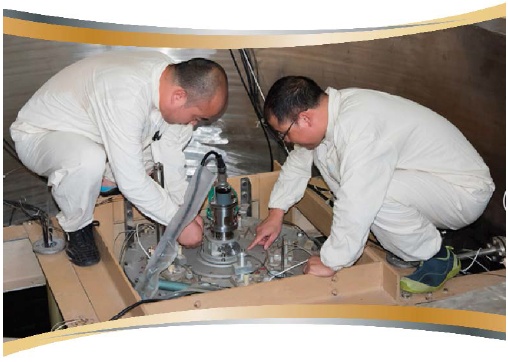
Members of the technical team make adjustments during a reactor conversion in Ghana. (Photo provided by NNSA)
In a series of Cold War arms control agreements, for example, the United States and Soviet Union increased transparency, moderated competition, codified rough parity in strategic nuclear arms, and closed off areas of competition. The most recent 2010 New START Treaty caps accountable U.S. and Russian strategic force levels, and includes some intrusive verification measures to help monitor compliance.
New START is in effect through February 2021 and with mutual agreement, may be extended for up to five years, to 2026. The United States has already met the Treaty's central limits which go into force on February 5, 2018, and will continue to implement the New START Treaty and verify Russian compliance.
Progress in arms control is not an end in and of itself, and depends on the security environment and the participation of willing partners. The United States is committed to arms control efforts that advance U.S., allied, and partner security; are verifiable and enforceable; and include partners that comply responsibly with their obligations. Such arms control efforts can contribute to the U.S. capability to sustain strategic stability. Further progress is difficult to envision, however, in an environment that is characterized by nuclear-armed states seeking to change borders and overturn existing norms, and by significant, continuing non-compliance with existing arms control obligations and commitments.
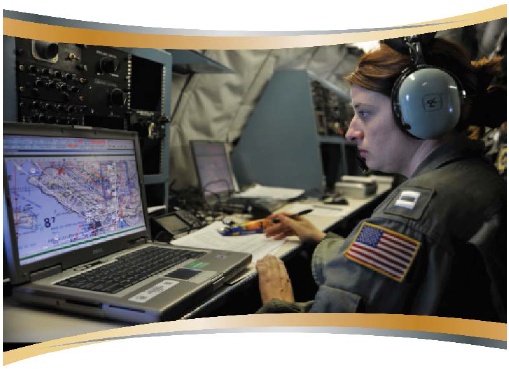
(State Department – Open Skies)
In this regard, Russia continues to violate a series of arms control treaties and commitments, the most significant being the INF Treaty. In a broader context, Russia is either rejecting or avoiding its obligations and commitments under numerous agreements, including the Conventional Armed Forces in Europe Treaty, the Budapest Memorandum, the Helsinki Accords, and the Presidential Nuclear Initiatives. In addition, Russia has violated the Open Skies Treaty and is selectively implementing the politically binding Vienna Document to avoid transparency of its major military exercises. Russia has also rebuffed U.S. efforts to follow New START with another round of negotiated reductions, and to pursue reductions in non-strategic nuclear forces.
Regarding the INF Treaty, the United States complies with and remains committed to preserving the Treaty. However, the value of the INF Treaty, or any arms control treaty, depends on all parties remaining in compliance. For over four years, the United States has pressed Russia to return to compliance, and will continue to exert appropriate pressure to restore Russian compliance and preserve the INF Treaty.

Air Force Master Sergeant calls range commands during a live-fire exercise at Fort Carson, Colo., June 9, 2017. He is the first sergeant assigned to the 233rd Support Group. (Air National Guard photo)
Nevertheless, Moscow must understand that the United States will not forever endure Russia's continuing non-compliance. The status quo, in which the United States continues to comply while Russia continues deployments in violation of the Treaty, is untenable. Agreements that are violated cannot provide predictability; undermine the prospects for future arms control; and can harm U.S., allied, and partner security. Concluding further agreements with a state in violation of multiple existing agreements would indicate a lack of consequences for its non-compliance and thereby undermine arms control broadly.
Consequently, the United States will work to convince states in violation of their legal arms control obligations to return to compliance. Arms control efforts must now emphasize confidence and security building measures to rebuild trust and communication. The United States seeks to reestablish the conditions necessary for greater trust with Russia and improved transparency with China as it expands and modernizes its nuclear forces.
The United States remains willing to engage in a prudent arms control agenda. We are prepared to consider arms control opportunities that return parties to predictability and transparency, and remain receptive to future arms control negotiations if conditions permit and the potential outcome improves the security of the United States and its allies and partners.
[Source: Office of the Secretary of Defense, Washington, Feb18]
 | This document has been published on 06Feb18 by the Equipo Nizkor and Derechos Human Rights. In accordance with Title 17 U.S.C. Section 107, this material is distributed without profit to those who have expressed a prior interest in receiving the included information for research and educational purposes. |